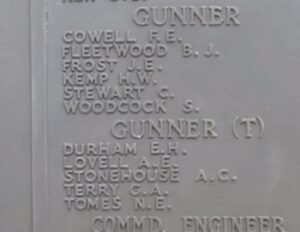Ystradgynlais is a small town situated in the northern Swansea Valley, on the banks of the River Tawe. The town is the largest in the historic county of Brecknockshire and developed around the ironmaking, coal mining and watchmaking industries. The men of the town who fell during both World Wars stands in Parc-yr-Orsedd, and also commemorated the fallen from the neighbouring villages of Abercrave, Cwmtwrch, Cwmgiedd, Glyntawe and Coelbren.
The Great War, 1914-1918
John Allen, Private, 15110, South Wales Borderers. John was born at Rowley Regis in about 1869. He married in 1895 and lived with his wife Alice Allen in Rowley Regis before getting a job as a labourer in a coal mine at Abercrave and moved his wife and their six children down to 14, Brookland Terrace, Abercrave. He enlisted at Ystradgynlais into the South Wales Borderers and was posted to the 1st Battalion, South Wales Borderers, which was in France attached to 3 Brigade, 1st Division. The division had been one of the first to arrive in France, fighting at the Battle of Mons, and taking part in the retreat to the Marne, where the Germans were stopped. They then fought at the Aisne, and at Chivy, before being moved north to Ypres. Here they fought at the First Battle of Ypres, where they again stopped the German Offensive, before wintering in Flanders, in the Festubert sector. The battalion supplied working parties for the first few weeks of 1915, moving to Givenchy on 14 January, where it continued work on trench consolidation. These weeks had been relatively quiet, but the peace was broken when the front line and canal lock at Givenchy came under fire on 24 January. This was a prelude to a larger bombardment which occurred the following day, at 08.00 on 25 January 1915, and saw the entire Givenchy front heavily shelled before the Germans attacked in force and penetrated Givenchy village. Heavy fighting continued for hours, but a combined effort from the 2nd Welsh, Black Watch and 1st South Wales Borderers finally drove the Germans back before mid-day. John was one of many men killed during the day. The 45-year-old has no known grave and is commemorated on panel 14 of the Le Touret Memorial, Richebourg-L’avoue, France.
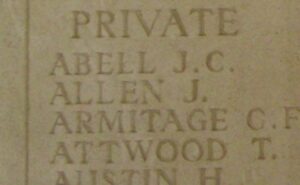
Daniel John Austin, Private, 17570, Welsh Regiment. Daniel was the son of William and Mary Austin, of Swansea. He married Mary Mochan at Ystalyfera on 4 May 1910 and the couple had four children over the coming years prior to the war, despite Daniel spending some time in HM Prison, Brecon. He enlisted into the 5th Battalion, South Wales Borderers at Ystradgynlais on 3 October 1914, but was discharged as medically unfit three weeks later. Daniel then re-enlisted at Swansea into the 14th Battalion, Welsh Regiment, which was known as the Swansea Pals battalion, and trained at Rhyl and Winchester before landing in France on 2 December 1915 attached to 114 Brigade, 38th (Welsh) Division. The division moved to the Fleurbaix area for trench initiation, then spent time holding various sectors down towards Cuinchy and by June 1916 was holding the line near Laventie. On 4 June 1916 the battalion sent out a raiding party which came into contact with the Germans in No Man’s Land and suffered the deaths of Lieutenant Corker and one man killed, one missing and another man wounded. Daniel was probably the man wounded during the raid, as he died of his wounds on the following day, 5 June 1916, aged 29. He is buried in grave II.H.5. in Royal Irish Rifles Graveyard, Laventie, France. His widow, Mary, married William Jones in 1918, and the couple lived at 4, Tudor Street, Garden City, Ystradgynlais.
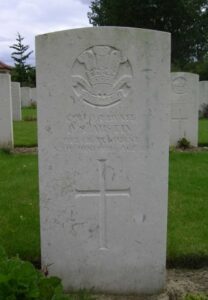
Rees Bamford, Private, 11036, Welsh Regiment. Rees was the son of Francis and Elizabeth Bamford, of St. David’s Road, Ystalyfera. He served with the 2nd Battalion, Welsh Regiment and was wounded in March 1915. He survived the war, marrying Elizabeth Cornelius in 1923, and died in 1969. He was probably a prisoner of war at some time, hence his mistaken inclusion on the war memorial.
Warren Ivor Boucher, Private, 2026, Herefordshire Regiment. Warren was the son of Walter and Annie Boucher, of 8, Powell’s Street, Penwyllt. He enlisted at Hereford into the 1st/1st Battalion, Herefordshire Regiment, which was attached to the Welsh Border Brigade, Welsh Division and in August 1914 moved to its war station at Pembroke Dock. The 53rd (Welsh) Division embarked at Devonport on 16 July 1915 for service at Gallipoli and landed at Suvla Bay on 9 August 1915. The Herefords were attached to 158 Brigade, which was sent out to take up positions in the front line, but soon became involved in a chaotic advance, mainly due to a lack of maps. Warren was killed in action during the day. The 20-year-old has no known grave and is commemorated on panel 198 of the Helles Memorial, Gallipoli.
Richard Butler, Private, 63432, South Wales Borderers. Richard was the son of John Henry Butler and Elizabeth Ann Butler, of Oddfellow Street, Ystradgynlais. He enlisted into the 3rd Battalion, South Wales Borderers and was posted to Sniggery Camp, where the battalion formed part of the Mersey Garrison. During October 1918 Richard came home on leave and had only been in Ystradgynlais a few hours when he suffered a seizure and collapsed. He then contracted pneumonia and died at home on 23 October 1918, aged 24. Richard is buried in the north west part of St. Cynog’s Churchyard, Ystradgynlais.
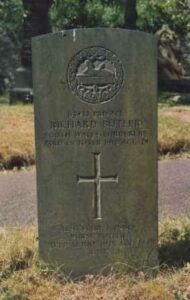
Frederick Herbert Carr, Private 2nd Class, 84099, Royal Air Force. Frederick was born in Chileston, Gloucester on 4 August 1885, the son of Frederick James Carr and Maria Carr (nee Bedwell). His father died when Frederick was only two years old and his mother re-married a year later. Frederick married Beatrice Annie Hasell at Keynsham, Somerset on 11 March 1911, before the couple moved to 9, Graig Terrace, Brecon Road, Ystradgynlais. Frederick had served with the Royal Air Force and had only been discharged a week before he died of influenza at Ystradgynlais on 13 December 1918, aged 32. He is buried in St. Cynog’s Churchyard, Ystradgynlais, and a special memorial in the churchyard commemorates him, as the exact location of his grave is unknown. His widow, Beatrice, married George Bayliss in 1921, and she died in 1927, aged only 35. His brother in law, Harry Hasell, was killed in 1916.
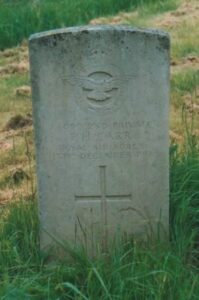
James Carter, Private, 3236, Welsh Regiment. James was born in Sheffield in 1886. He was living at 1 Richmond Terrace, Melincrythan, Neath by 1911, where he worked as a blacksmith and married Mary Hannah Jones of Ystradgynlais in 1912. James enlisted at Swansea into the 6th Battalion, Welsh Regiment, and was posted to Pembroke Dock. James died at Pembroke Dock Military Hospital on 29 July 1916, aged 30. He is buried in grave N.11. in Neath (Llantwit) Cemetery.
Joseph Thomas Chadford, Private, 29228, Welsh Regiment. Joseph was the son of William and Annie Elizabeth Chadford, of Swansea. By 1911 Annie was living with her family to 1, Oddfellows Street, Ystradgynlais. Joseph enlisted at Swansea into the 18th Battalion, Welsh Regiment and was transferred to the 14th Battalion, Welsh Regiment (Swansea Pals), which was attached to 114 Brigade, 38th (Welsh) Division and landed in France with the battalion on 2 December 1915. Whilst the division was in the trenches near Cuinchy, Joseph became one of a number of soldiers attached to the 254th Tunnelling Company, Royal Engineers, for work on mining duties. This was the company that the 14th Welsh was working alongside at Cuinchy when Sapper William Hackett gained the Victoria Cross whilst attempting to rescue another 14th Welsh man, Thomas Collins, who had been trapped underground when the Duck’s Bill crater was blown, and Joseph was most probably involved in the attempt. Hackett was killed in the attempted rescue and both men still lie underneath the green fields of Cuinchy today. Joseph was at some time transferred again, this time to the 2nd Battalion, Welsh Regiment, which was attached to 3 Brigade, 1st Division. He would have served on the Somme with either battalion, and also at the Third Battle of Ypres the following year. By the spring of 1918 Joseph was at Vermelles with the division when he was wounded during a quiet spell in the trenches. He died of his wounds on 25 June 1918, aged 19, and is buried in grave V.C.28. in Pernes British Cemetery, France.
William Thomas Clifford, Lance Sergeant, 7975, South Wales Borderers. William was born in Cheltenham in 1886, the son of Henry and Annie Clifford. The family moved to Brecon in about 1893, where Henry kept his own butchers shop. William enlisted into the South Wales Borderers in 1903 and served in South Africa until contracting enteric fever and was hospitalised at Bloemfontein before being sent home. He spent three years at Brecon before leaving the army early in 1911 and lived with his brother Robert at Church Terrace, Ystradgynlais after finding work as a coal picker. He married Daisy Olive Dugdale in 1912. William re-joined the colours when war erupted and he embarked for France with the 1st Battalion, South Wales Borderers, which was attached to 3 Brigade, 1st Division. The division landed in France on 12 August 1914 and moved to Mons with the BEF, taking part in the subsequent retreat from Mons to the Marne and from 12 September fought in the Battle of the Aisne. Conditions during the retreat were terrible, the war diary of the 1st SWB for 16 September states: ‘I have never spent and can imagine that I will never spend a more ghastly and more heart-tearing forty eight hours than the last…’ The day was one of incessant fighting, which continued over the coming days. William was killed in action on 18 September 1914 when he was shot through the lungs. The 28-year-old was buried on the battlefield by a comrade who had been in school with him in Brecon, but his grave was lost, so he is now commemorated on the La Ferte-Sous-Jouarre Memorial, France.
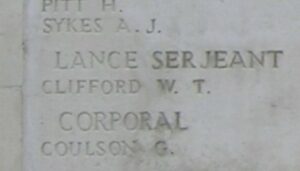
John Henry Cole, Sapper, 108003, Royal Engineers. John was born in Salcombe, Devon, the son of George Samuel and Jane Cole. The family later moved to Sunny Bank, Brecon Road, Ystradgynlais, and then to 17, School Road, Onllwyn. John worked as a bricklayer prior to enlisting at Ystalyfera into the Royal Engineers on 25 March 1915 and was posted to the Deganwy Depot for training. On 3 July 1916 he embarked for France, joining the 126th Field Company, Royal Engineers, which was attached to the 21st (Light) Division. The division moved to the Somme that summer to take part in the offensive there, fighting in the Battles of Albert, Bazentin and Flers-Courcelette. On 25 September 1916 the division took part in the next phase of the offensive, the Battle of Morval, and it was during this first day of the battle that John was reported as missing, presumed killed. No trace of him was ever found, so John is officially recorded as having been killed in action on the date he went missing, 25 September 1916, aged 21. He has no known grave and is commemorated on pier and face 8A and 8D of the Thiepval Memorial, France.
Leonard William Colwell, Corporal, 15313, Machine Gun Corps. Leonard was born in Hatfield, Herefordshire, the illegitimate son of Harriet Colwell. His mother later married George Christopher Passey, of Dhobie Cottage, Hatfield, Leominster. Leonard came to Abercrave to work prior to the war and lived at Troedybryn Terrace with his uncle and aunt before returning to Leominster to enlist into the King’s Shropshire Light Infantry. He was posted to France where he transferred into the 8th Battalion, Machine Gun Corps, which was attached to the 8th Division. The Division had been in France since November 1914, and had fought at the Battle of Neuve Chapelle, and then at the Battle of Aubers. It saw further fighting at the Action of Bois Grenier, before moving to the Somme in 1916 and took part in the great offensive there. In March 1917 the division followed the German Retreat to the Hindenburg Line, and later that year moved to Ypres, fighting at the Battles of Pilckem and Langemarck. In March 1918 the Division was on the southern end of the Somme, and met the German Offensive head on seeing heavy fighting over the coming weeks. Leonard was killed in action on the Somme on 26 April 1918, just before the division was pulled from the line to rest. The 23-year-old is buried in Crouy British Cemetery, Crouy-sur-Somme, France.
Herbert Ernest Corfield, Sergeant, 22200, South Wales Borderers. Herbert was the son of Thomas and Ellen Corfield, of Penn, Staffordshire. He married a widow, Ada Leaver (nee Jones), on 26 May 1901 and had a daughter Gladys Louisa May Corfield. He lived at Ystradgynlais prior to the war and enlisted there under the name of Henry Corfield into the 11th Battalion, South Wales Borderers. The battalion trained at Colwyn Bay and Winchester before embarking for France with 115 Brigade, 38th (Welsh) Division on 4 December 1915. The division moved to the Fleurbaix sector for trench initiation before holding the line by itself at various spots from Cuinchy up to Fromelles. In June 1916 it marched south to the Somme sector in order to take part in the offensive there and on 7 July 1916 launched its first assault on Mametz Wood. Herbert would have taken part in the terrible fighting that day, when 115 Brigade was sent into battle, but was beaten off with heavy losses. The division re-organised and attacked again on 10 July, finally clearing the wood before being evacuated on 12 July. It moved to Hébuterne for a short period before taking up the line along the canal bank at Boesinghe, north of Ypres, where it would remain for the next twelve months. Herbert was killed in action there during a terribly wet and miserable day on 9 December 1916, aged 43. He is buried in grave III.D.41. in Essex Farm Cemetery, Belgium.
John Cullen, Lance Corporal, 3/8156, Devonshire Regiment. John was the son of James and Elizabeth Cullen, of Ystradgynlais. He enlisted at Gorseinon into the 3rd Battalion, Devonshire Regiment, and was posted to France on 21 September 1915, joining the 1st Battalion, Devonshire Regiment, which was near Ypres attached to 14 Brigade, 5th Division. On 12 January 1916 the battalion transferred to 95 Brigade in the same Division. In March 1916 the Division moved to positions between St. Laurent-Blangy and Vimy, near Arras, where it saw much fighting. It was moved south in order to take part in the Somme offensive some months later and remained there until being moved to Festubert to rebuild in October 1916 following heavy losses. The division then moved south, taking part in the Battle of Arras and captured Oppy Wood. On 7 September 1917 the division was moved back to Ypres to take part in the great offensive there and from 26 September fought at the Battle of Polygon Wood. The division took part in all of the subsequent phases of the Third Battle of Ypres. John was killed in action during the Second Battle of Passchendaele on 31 October 1917, aged 22. He has no known grave and is commemorated on panel 38 to 40 of the Tyne Cot Memorial, Belgium.
David Davies, Private, 267441, Monmouthshire Regiment. David was from Aberdare, possibly the son of David James Davies, of 15, Queen Street. He lived at Smithfield, Ystradgynlais and worked at the Ystradfawr Colliery prior to the war. He was engaged to Miss Beatrice Rowe, of Station Road, Ystradgynlais prior to enlisting into the Monmouthshire Regiment, and landed in France at some time after 1916, joining the 2nd Battalion, Monmouthshire Regiment, which was by then the Pioneer Battalion to the 29th Division. The division saw heavy fighting on the Somme in 1916 and fought at the Battle of Arras, the Third Battle of Ypres and the Battle of Cambrai in 1917. On 18 January 1918 the division took over a sector of the Passchendaele Salient and on 12 February moved to the Steenwarde sector. On 9 April 1918 the Germans launched their second offensive of the year, this time along the Lys valley, and broke through the Allied lines. The 29th Division was moved quickly to Neuf Berquin, between Merville and Estaires, where it was hit hard by the Germans on the morning of 11 April. Forced to withdraw under the weight of overwhelming numbers, the division saw terrible fighting over the coming days. David was killed in action at some time on 12 April 1918. He has no known grave and is commemorated on panel 10 of the Ploegsteert Memorial, Belgium.

David John Davies, Private, 93951, Royal Welsh Fusiliers. David was the son of John and Eleanor Davies, of 29, Oddfellows Street, Ystradgynlais. He enlisted at Brecon into the South Wales Borderers on 16 April 1918 and landed in France on 30 September 1918, where he was posted to the 16th Battalion, Royal Welsh Fusiliers, which was attached to 113 Brigade, 38th (Welsh) Division. He joined up with the battalion at Heudicourt, a village south-west of Gouzeaucourt, on 2 October 1918. The division was taking part in the great offensive towards the Hindenburg Line, which was broken on 29 September, and was enjoying a brief respite before moving forwards again. Two days later the battalion began moving forwards through Lempire to positions facing Mortho Wood, in order to assault the wood on 8 October. The barrage opened at 01.00 on 8 October 1918 and the battalion attacked along with the entire 113 Brigade and suffered terrible casualties due to machine-gun fore from the wood. David was among 158 casualties suffered by his battalion alone during the attack that morning. He was 20 years old and is buried in grave I.B.8. in Bois-Des-Angles British Cemetery, Crèvecoeur-Sur-L’Escaut, France.
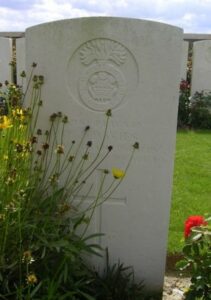
H. Davies. This man cannot presently be identified.
H. G. Davies. This man cannot presently be identified.
L. Davies. This man cannot presently be identified.
R. Davies. This man cannot presently be identified.
Richard George Davies, Driver, 899, Royal Field Artillery. Richard was the son of George and Elizabeth Davies, of Glynneath. He lodged at Cwmgiedd, Ystradgynlais prior to the war and worked as a collier. Richard enlisted at Neath into the 38th (Welsh) Division, Royal Field Artillery but did not embark with the division for France in December 1915. Instead he was posted to France in 1916 joining C Battery, 60th Brigade, Royal Field Artillery, which had arrived in France with the 11th (Northern) Division in June 1916 following service at Gallipoli. The division moved to the Somme in order to take part in the offensive there. Richard was not in France long when he was run over by a gun carriage. He was evacuated to hospital but died of his injuries at No 2 Stationary Hospital, Abbeville on 19 October 1916 aged 32. He is buried in grave I.G.4. in Abbeville Communal Cemetery Extension, France.
Thomas Davies, Private, 13119, Devonshire Regiment. Thomas was born at Ferndale, the son of Thomas Davies. The family lived at Ystradgynlais prior to the war. Thomas enlisted at Ynyshir into the Devonshire Regiment. He landed in France on 21 December 1915 and was posted to the 1st Battalion, Devonshire Regiment, which was attached to 14 Brigade, 5th Division. On 12 January 1916 the battalion transferred to 95 Brigade in the same Division. The division moved to a position near Arras, between St. Laurent-Blangy and Vimy in March 1916, where it saw some fierce fighting. It was then transferred south in order to take part in the Somme offensive and saw its first action there during the assaults on High Wood. The divisions next action was during the Battle of Guillemont, when the 5th Division relieved the battered 35th Division during the night of 26 August. Thomas was killed in action during heavy fighting near Falfemont Farm on 4 September 1916. He has no known grave and is commemorated on pier and face 1C of the Thiepval Memorial, France. Thomas does not appear to be commemorated locally.
Thomas Howell Davies, Captain, South Wales Borderers. Thomas was born at St. Clears in the winter of 1886, the son of Thomas and Anne Davies, of the Holly Bush Inn, Station Road. His father was a Coal and Lime Merchant. By 1901, Thomas was living with his Grandfather at Waungron Farm, Whitland, and he was educated at Whitland Grammar School. Thomas became a Schoolmaster at Llanybydder prior to the war, and at the outbreak of war enlisted into the London Rifles. Thomas was by then living in London, and he married Edith Newman there in 1916, before being commissioned into the South Wales Borderers on 23 January 1916, and was posted to France with the 11th Battalion, South Wales Borderers, which formed part of 115 Brigade, 38th (Welsh) Division. Thomas fought with the Division throughout the war, at Mametz Wood in 1916, at Pilckem Ridge in 1917. Thomas was probably gassed whilst the 38th Division was at Armentieres early in 1918, before the 11th SWB were disbanded in February 1918, and was invalided back to Llain-y-Gors, Ystradgynlais, where Edith had set up home with their young son. Thomas succumbed to his gas wounds and died on 6 October, 1919 aged 33. He is buried in Ystradgynlais (St. Cynog) Churchyard.
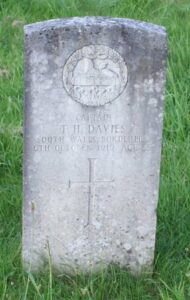
Ronald Guy Dawes, Private, 290694, Welsh Regiment. Ronald was the son of Archibald and Elizabeth Dawes, of Gough Building, Ystradgynlais. He enlisted into the Welsh Regiment and was posted to France, probably after the assault of the 38th (Welsh) Division on Pilckem Ridge on 31 July 1917, to join the 10th Battalion, Welsh Regiment, which was attached to 114 Brigade of the Division. He joined the division when it was still in the Ypres sector just prior to its move to the Armentieres sector where it spent the coming months. As a result of the emergency caused by the German’s Spring Offensive on the Somme, the 38th (Welsh) Division was transferred south, ordered to take up the line north of Albert, facing Bouzincourt Ridge. By now several of the battalions in the division had been disbanded and Ronald had been transferred to the 15th Battalion, Welsh Regiment (Carmarthen Pals), in the same Brigade. It held this sector before launching its offensive across the flooded valley of the River Ancre on 21 August 1918, with the 15th Welsh leading the way, and over the coming days captured the Thiepval Ridge. Ronald was killed during the assault on Common Lane, a trench between St. Pierre Divion and Pozieres, on 23 August 1918, aged 18. He has no known grave and is commemorated on panel 7 of the Vis-en-Artois Memorial, Haucourt, France.
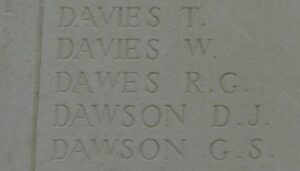
Daniel William Cyril De La Haye, Second Lieutenant, Royal Engineers. Daniel was the son of Herbert and Annie De Lay Haye, of Ystradgynlais. He was educated at Ystradgynlais County School and was a scout-master in the 1st Swansea Valley Troop of Boy Scouts prior to becoming a student at Cardiff University, where he was captain of the football team. He enlisted into the Public Schools Battalion, Royal Fusiliers and was transferred to the Royal Engineers, gaining the rank of corporal and landing in France on 26 August 1915. Daniel was commissioned as second lieutenant on 8 September 1917, and served with N Special Company, which was a specialist gas warfare unit. The unit had been deployed at Monchy during 1916 and then moved to Auchy before being sent to Dixmude in September 1917. By 5 April 1918 it had been deployed to the Somme sector, and was based in the Ancre valley, by the 38th (Welsh) Division. Daniel was wounded on the Somme soon afterwards and died of his wounds on 23 May 1918 aged 24. He is buried in grave III.B.3. in Varennes Military Cemetery, France.
Phillip Draper, Private, 15526, Monmouthshire Regiment. Phillip was the illegitimate son of Mrs. Mary Jane Vellacott, of Church Lane, Ivybridge, Barnstaple, Devon. He lived at Dyffryn Clwyd, Ystalyfera prior to the war and worked as a bricklayer’s labourer. Phillip enlisted at Ystradgynlais into the South Wales Borderers and was posted to France at some time in 1916, joining the 2nd Battalion, Monmouthshire Regiment, which was the pioneer battalion to the 29th Division. The division had suffered terrible casualties following its assault against Y-Ravine on the opening day of the Somme offensive, on 1 July 1916 and was pulled from the line to rebuild. It moved back into the line in time to take part in the fighting around Le Transloy and Gueudecourt. The division wintered on the Somme and during most of December the 2nd Monmouths carried out vital work in the Montauban area, repairing roads and constructing a light railway from Guillemont to Combles. By the beginning of January, the division had moved out of the line to train, and the 2nd Monmouths carried out practise attacks as part of the divisional plan of training. By 12 January 1917 the 2nd Monmouths had begun to move back towards the Montauban area again, and on 18 January 1917 the battalion was at work improving trenches, shelters and dugouts around Plank Avenue when Phillip was killed by a shell which hit one of A Company’s shelters. The 21-year-old has no known grave and is commemorated on pier and face 4A on the Thiepval Memorial, France.
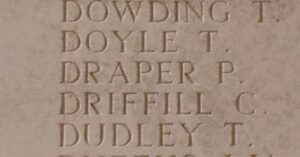
Richard Edwards, Private, 43176, Leicestershire Regiment. Richard was the son of William and Margaret Edwards, of 10, Philip Street, Mountain Ash. He married Martha Jane Lewis, of Ystradgynlais in 1901 before the couple set up home at Ynyslas, Ystradgynlais, and the couple adopted a young daughter, Catherine Jane Lake. Richard worked as a collier before he enlisted into the 3rd Battalion, Somerset Light Infantry. He was then transferred to the 10th Battalion, Welsh Regiment and was later posted to the 1st Battalion, Leicestershire Regiment. The battalion was attached to 71 Brigade, 6th Division and by the spring of 1918 was one of those hit by the German Offensive on the Somme, which had been launched on 21 March. After suffering heavy casualties the division was moved from the line, and went to Flanders to rest, but the following month the Germans launched another offensive on the Lys, and the Division got caught up in further terrible fighting. When the Germans launched their Lys offensive on 9 April 1918 the division was at rest around Belgian Battery Corner Camp, near Ypres and was moved to positions at Dranoutre. At 4 pm the 1st Leicesters were hit by a German artillery bombardment and then came under attack by the German infantry. Richard was killed in action during the fighting that day, on 15 April 1918, aged 39. He has no known grave and is commemorated on panel 50 to 51 of the Tyne Cot Memorial, Belgium.
David Evans, Private, 37705, Welsh Regiment. David was born at Llanelli. He married Elizabeth Jones, of Morriston, in 1900 and the couple had five children before moving to 5, Glantawe, Ystradgynlais prior to 1911. David enlisted at Brecon into the army, and was posted to the 1st Battalion, Welsh Regiment, which was attached to 84 Brigade, 28th Division. The Division formed in England from December 1914, from regular units returning from service around the Empire. During January 1915 it moved to France, landing at Le Havre and moved to the Western Front, where it saw its first major action during the Second Battle of Ypres. The Division suffered heavy casualties here, and didn’t see major action until the Battle of Loos on 25 September 1915. David was killed at Loos on 2 October 1915, aged 37. He is commemorated on panel 77 to 78 of the Loos Memorial, France.
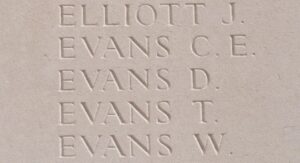
James Walter Evans, Sapper, 398112, Royal Engineers. James was the son of John and Mary Evans, of Glan-yr-Avon, Ystradgynlais. He was a tailor prior to the war and married to Dorothy Sanderson Hopper, of 7, Albion Street, Driffield, Yorkshire, in 1914. James enlisted at Birmingham into the Royal Engineers and was posted to France with the 497th Field Company, Royal Engineers, which was attached to the 29th Division. The division had fought in Gallipoli before moving to France in 1916 and saw heavy fighting on the Somme that summer. It fought at Arras and at Passchendaele in 1917 and at the end of the year took part in the Battle of Cambrai. The division moved back to the Lys sector early in 1918. James was at work behind the lines when he was badly wounded by shrapnel from an exploding German shell soon after the move north. He died of his wounds on 28 April 1918, aged 28, and is buried in grave II.H.2. in Aire Communal Cemetery, France.
William Richard Evans, Sapper, 92570, Royal Engineers. William was the son of Richard and Sarah Evans, of Tanygraig House, Felinfach, Ystradgynlais. He worked at the Black Mountain Silica Works prior to the war and enlisted at Ystalyfera into the Royal Engineers. He embarked for France with the 38th (Welsh) Division on 3 December 1918. At some time afterwards, William was transferred to the 228th Field Company, Royal Engineers, which was attached to the 41st Division. A year later, on 1 December 1916, while William was in France, his father Richard was injured by a roof fall at the Cwmllynfell Colliery, and died in Swansea Hospital on 21 December 1916. Williams division took part in the Somme offensive before moving to Ypres early in 1917 and took part in the Passchendaele offensive, before being despatched to Italy. It was hurried back to the Western Front in early March 1918 and faced the German Spring Offensive of 21 March 1918. The division saw much fighting before being withdrawn and sent north to Flanders. William returned home on sick leave during this time and had not long returned to the front when he was killed, on 24 July 1918, aged 26. He is buried in grave XXVIII. G. 14. in Lijssenthoek Military Cemetery, Belgium. William does not appear to be commemorated locally.
Samuel Fletcher, Private, 62781, Royal Army Medical Corps. Samuel was born in Pontypool in 1868, the son of Samuel and Jane Fletcher. The family had moved to Lydbrook, Gloucester by 1881 and Samuel married Alice Robins there in 1892. By 1901 the couple had moved to Church Street, Ystradgynlais, and Samuel worked at the Yniscedwen Tinplate Works prior to the war. He was a member of the St. John’s Ambulance and enlisted in August 1915 into the Royal Army Medical Corps before being posted to Aldershot for training. Samuel was in training at Aldershot and was preparing to go to France when he suffered an asthma attack and died at Cambridge Hospital, Aldershot on 21 December 1915, aged 47. His body was brought home to his wife’s birthplace in the Forest of Dean where he was buried with full military honours in grave 3.4. in Lydbrook Baptist Chapelyard on Boxing Day.
George Haydn Francis, Private, 36293, Welsh Regiment. George was the son of John and Sarah Ann Francis, of Ystradgynlais. He married Emily Ellen Earland in 1902 and the couple lived at 10, Spencer Terrace, Lower Cwmtwrch. George enlisted at Brecon into the South Wales Borderers soon after the outbreak of war, and was posted to France on 5 May 1915, joining the 1st Battalion, Welsh Regiment, which was attached to 84 Brigade, 28th Division. George joined the battalion at Ypres, in atrocious conditions, in the midst of the battle of Frezenberg Ridge. He was wounded soon after arriving at the front and evacuated to No 10 Stationary Hospital, St. Omer, where he died of his wounds on 25 May 1915, aged 33. George was buried in grave I.A.138. in Longuenesse (St. Omer) Souvenir Cemetery, France.
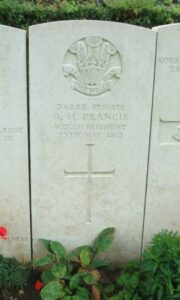
William Francis, Lance Corporal, 28582, Welsh Regiment. William was born in Warminster. He worked as a coal hewer at Abercrave prior to the war and lived at Shop House. William enlisted at Ystalyfera into the 18th Battalion, Welsh Regiment (2nd Glamorgan), which was attached to 119 Brigade, 40th (Bantam) Division. The Division moved to France during the first week of June 1916, and moved to the front near Loos. Late in 1916 it moved south to the Somme, and fought at the Battle of the Ancre, remaining in the Rancourt sector over the winter. During the first days of January 1917 the battalion was holding the line in the Rancourt Sector, and suffered a number of casualties on a daily basis, with several men wounded and a number of men being posted sick due to the terrible conditions, before being relieved on 4 January. William was among the men wounded at this time and was evacuated to the base hospital at Boulogne where he died of his wounds on 13 January 1917, aged 31. He is buried in grave VIII. C. 179. in Boulogne Eastern Cemetery, France.
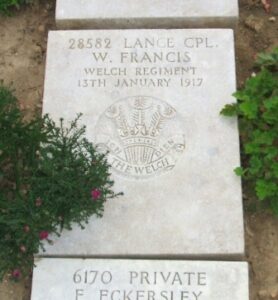
Tom Charles Fuller, Private, 7719, Welsh Regiment. Tom was the son of Clement and Lizzie Fuller, of Swansea. By 1911 he was living with his uncle, William Bowen, at 79, New Street, Burry Port. He is listed as residing at Ystradgynlais prior to enlisting into the 2nd Battalion, Welsh Regiment, which was part of 3 Brigade, 1st Division. The Division had been one of the first to arrive in France, fighting at the Battle of Mons, and taking part in the retreat to the Marne, where the Germans were stopped. They then fought at the Aisne, and at Chivy, before being moved North to Ypres. Here they fought at the First Battle of Ypres, and it was here that Tom was probably wounded. He was moved to the Base Hospital at Wimereux where he sadly died of wounds on 7 November 1914, aged 32. Tom is buried there at Wimereux Communal Cemetery, France. He was the cousin of William Fuller of Laugharne and Swansea, the first Welshman to win the Victoria Cross during the Great War. Tom is not commemorated at Ystradgynlais but at Burry Port.

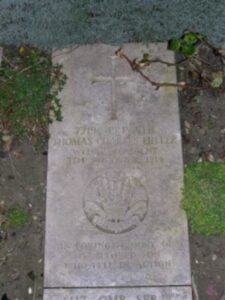
Harry Bickerdike Furness, Private, 17775, Welsh Regiment. Harry was born in Farnley, Yorkshire in 1889, the son of James Russel Furness and Mary Jane Furness. Following the death of his father in 1891, his mother married John William Givens and the family lived in 22, Nutting Road, Farnley. The family moved to Cwmtwrch prior to the war and lived at Mount Pleasant, Gurnos. Harry enlisted at Swansea into the 14th Battalion, Welsh Regiment (Swansea Pals) soon after the outbreak of war. The battalion trained at Rhyl before moving to Winchester as part of 114 Brigade, 38th (Welsh) Division and landed in France on 2 December 1915. The division was initiated into the arts of trench warfare in the Fleurbaix sector, before holding the line itself at Cuinchy, and near Neuve Chapelle before being moved to the Somme in June 1916. On 7 July 1916 115 Brigade of the division made a frontal assault on Mametz Wood but were repulsed with heavy losses, and three days later, on 10 July 1916, the attack was renewed. Harry was killed in action during the horrific fighting within the wood that day. The 28-year-old has no known grave and is commemorated on pier and face 7A and 10A of the Thiepval Memorial, France. His step-brother, William Sherlock Givens was taken prisoner by the Germans after being captured at Mametz Wood, while his step-father, John William Givens also served before succumbing to ill health in 1918.
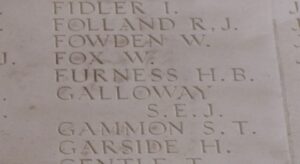
James William Givens, Private, M2/098458, Royal Army Service Corps. James was born at Wortley, Yorkshire on 23 December 1872, the son of Alfred and Hannah Givens. He married the widowed Mary Jane Furness on 22 December 1894. He moved the family to Cwmtwrch after gaining employment as a waggon repairer at the Midland Railway Yard, Gurnos prior to the war. He volunteered to serve in the army early in the war and became a driver with the Royal Army Service Corps at Marlborough, before being sent overseas on 17 July 1915 to serve in France, at Le Havre and Rouen. By June 1918 his health had begun to suffer and he was invalided home after suffering a severe bout of fever. He died at home in Cwmtwrch on 30 November 1918, aged 45. John was buried with full military honours in Cwm-Twrch Isaf (Beulah) Welsh Baptist Burial Ground. His son, William Sherlock Givens, was a prisoner of war for over two years, while his step-son, Harry Bickerdike Furness, was killed at Mametz Wood.
John Thomas Grice, Private, 24911, King’s Shropshire Light Infantry. John was the son of Thomas and Elizabeth Grice of Colbren Villa, Ystradgynlais. He married Mary Jane Lewis in 1904 and the couple moved into London House, Colbren. John worked as a collier prior to enlisting at Colbren into the King’s Shropshire Light Infantry. He was posted to France at some time in 1916, joining the 7th Battalion, King’s Shropshire Light Infantry, which was attached to 8 Brigade, 3rd Division. He served with the battalion during the Somme offensive that summer and was invalided home in the spring of 1917 after suffering frostbitten feet whilst in the trenches over the winter of 1916-17. By the summer he had recovered enough to re-join his battalion in France and was presented with a clock at a reception at Colbren before leaving. He then fought with the division during the Third Battle of Ypres and also at Cambrai later in the year before wintering in the Arras sector. When the Germans launched their spring offensive on 21 March 1918 the division was hit hard, suffering a number of casualties and began a fighting withdrawal over the coming days. The depleted division suffered terrible casualties, especially on 28 March when the Germans attacked them with ‘great violence’. John was reported as missing during the terrible fighting of 28 March 1918 and was later reported to have been captured and taken prisoner by the Germans. Sadly, he had in fact been killed in action on 28 March 1918, aged 39. John has no known grave and is commemorated on bay 7 of the Arras Memorial, France.
D. Griffiths. This man cannot presently be identified, but two men named David Hughes, of Ystradgynlais, fell during the war, yet only one is named on the memorial, so is this name an error and should read D. Hughes? See below for the entries on David Hughes.
David Griffiths, MM, Corporal, 282634, Royal Garrison Artillery. David was the son of David Thomas Griffiths and Sarah Griffiths, of Cwmgiedd, Ystradgynlais. He worked as a collier prior to enlisting at Swansea on 2 November 1915 into the Royal Garrison Artillery. He embarked for France from Folkestone on 12 October 1916 and after landing at Boulogne was posted to the 194th Siege Battery, Royal Garrison Artillery. David was a good soldier and soon gained promotion to Bombardier and then to Corporal and became the first man from Ystradgynlais to be awarded the Military Medal, possibly for his actions during the German Spring offensive of 1918. He was wounded around the time of the launching of the great offensive which ultimately won the war and died of his wounds at the 3/2 West Lancs Field Ambulance on 8 September 1918, aged 32. David was originally buried in a small, isolated cemetery, but his grave was exhumed after the war and he was buried in grave VII.H.12. in Quéant Road Cemetery, Buissy, France.
Isaac John Griffiths, Private, 11639, South Wales Borderers. Isaac was the husband of Mary Griffiths, of Troed-y-Rhiw Cottages, Abercrave. He was an army reservist and worked at the International Colliery prior to re-enlisting at Brecon into the 2nd Battalion, South Wales Borderers. The battalion had landed at Plymouth on 4 December 1914 following a successful campaign against the German garrison of Tsingtao in China. It entrained for Rugby to join 87 Brigade, 29th Division and embarked with the division at Avonmouth on 17 March 1915 to sail for Egypt, before landing at Gallipoli on 25 April 1915. The division saw much action during the Gallipoli campaign before being evacuated to Egypt on 11 January 1916 and after a brief rest sailed for Marseilles where it disembarked on 15 March 1916, entraining for the Somme. The Division took part in its first major action in France during its attack on Beaumont Hamel on 1 July 1916, and suffered heavy casualties. It fought in the latter stages of the Somme offensive before moving to the Arras sector and fought at the Battle of the Scarpe in April 1917. It was then moved to Ypres and fought at the Battle of Langemarck, and then at the Battles of the Menin Road, Polygon Wood, Broodseinde and Poelcappelle, before moving to Cambrai. Here the division fought at the Battle of Cambrai in November and December 1917 before moving back to Flanders early in 1918, and got caught up in heavy fighting following the launching of the German offensive on the Lys on 9 April 1918. The war turned in favour of the Allies after a series of successes on the Somme in August 1918. The 29th Division then took part in the Offensive in Flanders, where they took part in the Action of Outtersteene Ridge. Isaac was wounded here, and died of his wounds at the 2nd Australian Casualty Clearing Station at St. Omer on 19 August 1918, aged 40. He is buried in grave V. D. 66. in Longuenesse (St. Omer) Souvenir Cemetery, France. He left a widow and four young children.
John Griffiths, Private, 29775, King’s Shropshire Light Infantry. John was born in Ystradgynlais, the son of Griffith John and Alice Griffiths. The family later moved to Maesydyffryn, Onllwyn following the death of Alice in 1904. John enlisted at Neath into the 17th Battalion, Welsh Regiment, with the service number 26184. The battalion was attached to 119 Brigade, 40th (Bantam) Division and John would have served with it during its famous assault on Bourlon Wood, during the Battle of Cambrai. The battalion was disbanded on 9 February 1918 and John was posted to the 9th Entrenching Battalion temporarily, before being re-posted to the 10th Battalion, King’s Shropshire Light Infantry, which was attached to 231 Brigade, 74th (Yeomanry) Division. The division arrived in France in May 1917 after extensive service in Egypt and Palestine and moved to Flanders to familiarise itself with the different conditions. It then moved to the Somme sector in order to take part in the advance on the Hindenburg Line. On 18 September the division took place in a combined attack all along the front, against the Hindenburg outpost defences, with their own sector being centred near Ronssoy. Terrible fighting raged throughout the day, which proved a success for the Allies. John’s battalion remained in the line over the coming days prior to the offensive being resumed on the 21st. He was killed in action a day before the resumption of the battle, on 20 September 1918, aged 21. He has no known grave and is commemorated on panel 8 of the Vis-en-Artois Memorial, Haucourt, France. John does not appear to be commemorated locally.
David Harris, Sapper, 147880, Royal Engineers. David was the son of Peter and Margaret Harris, of School House, Oddfellows Street, Ystradgynlais. He lived at 6, Davies Row Fforestfach, Swansea prior to enlisting at Swansea along with his brother William into the 14th Battalion, Welsh Regiment (Swansea Pals). He trained with the battalion at Rhyl and Winchester before it moved to France on 3 December 1915 attached to 114 Brigade, 38th (Welsh) Division. Whilst training in the Fleurbaix and Cuinchy sectors, a number of men from the division became attached to Tunnelling Companies of the Royal Engineers, and it was during this time that David transferred into the 255th Tunnelling Company, Royal Engineers, which formed in January 1916 before moving into the Red Lamp-Neuve-Chapelle sector. The company then moved into the Laventie-Fauquissart sector for a short while before relieving the 180th Tunnelling Company in the Givenchy area. David was gassed whilst working in this sector in December 1916 and died as a result on 23 December 1916, aged 27. He is buried in grave I.A.11. in Fosse No.10 Communal Cemetery Extension, Sains-en-Gohelle, France. His oldest brother, William, was wounded soon afterwards whilst serving with the Swansea Pals.
Harry Hasell, Private, 29033, Welsh Regiment. Harry was born in Timsbury, Somerset, the son of Arthur and Sarah Ann Hasell. The family moved to Ystradgynlais prior to the war, following the marriage of their daughter Beatrice Annie Hasell to Frederick Herbert Carr. Harry enlisted at Swansea into the 14th Battalion, Welsh Regiment (Swansea Pals), which trained at Rhyl and Winchester before landing in France on 3 December 1915 attached to 114 Brigade, 38th (Welsh) Division. The division moved to the Fleurbaix sector for trench initiation and held various sections of the line from there down to Cuinchy before marching south in June 1916 in order to take part in the Somme offensive. It assaulted Mametz Wood on 7 July 1916 but was repulsed after suffering heavy losses, before renewing the attack on 10 July. After two days of terrible fighting the division was evacuated from the wood and moved to Hébuterne before taking up positions north of Ypres, along the Boesinghe canal banks. Harry was killed in action here when the 14th Welsh was at work on improving Burnt Cable trench near Brandhoek on 18 August 1916, aged 21. He is buried in grave III.D.36. in Essex Farm Cemetery, Belgium. There was some confusion regarding his death, as his family was told in a letter from Captain Milburne Williams that he had been killed during the charge at Mametz Wood on 10 July, but they then saw him in the film The Battle of the Somme. His parents later lived at 69, High Street, Aberavon. His brother in law, Frederick Herbert Carr, was killed in 1918.
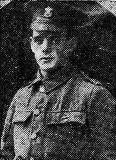
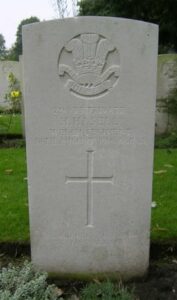
Lewis Holt, Private, 17809, Welsh Regiment. Lewis was born in Garnant, the son of John and Mary Jane Holt. After his father’s death his mother moved the family to Oakfield, Lower Cwmtwrch, Swansea. Lewis enlisted at Ystalyfera into the 14th Battalion, Welsh Regiment, known as the Swansea Pals, which was attached to 114 Brigade, 38th (Welsh) Division. The Division landed in France during the first days of December 1915 and had spent their first winter in the trenches near Armentieres. In June they marched south to the Somme, where they were tasked with the capture of Mametz Wood. The attack on the wood began on 7 July, but met with fierce resistance, and it took until 11 July to clear the wood. Lewis was wounded during one of the attacks, being shot through the chest, and was brought to the Casualty Clearing Station at Heilly for treatment. He died of wounds there on 24 July 1916, aged 22, and is buried in grave II.C.55. in Heilly Station Cemetery, Mericourt-L’Abbe, France.
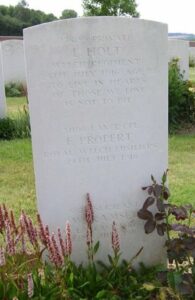
William Hosking, Private, 39620, South Wales Borderers. William was born in Devonport, the son of John and Clara Hosking. His sister, Mrs. Annie Lewis, lived at Bridgend Cottage, Abercrave, and when William was old enough he moved to 5, Brickyard, Abercrave, where he found work as a collier. William enlisted at Bridgend into the Glamorgan Yeomanry and upon being posted to France joined the 2nd Battalion, South Wales Borderers, which was attached to 87 Brigade, 29th Division. He probably joined the battalion in France while it was rebuilding following its near annihilation at Beaumont Hamel on 1 July 1916. The division returned to action and fought in the latter stages of the Somme offensive before moving to the Arras sector and fought at the Battle of the Scarpe in April 1917. It was then moved to Ypres and fought at the Battle of Langemarck, and then at the Battles of the Menin Road, Polygon Wood, Broodseinde and Poelcappelle, before moving to Cambrai. Here the division fought at the Battle of Cambrai in November and December 1917 before moving back to Flanders early in 1918 and got caught up in heavy fighting following the launching of the German offensive on the Lys on 9 April 1918. The war turned in favour of the Allies after a series of successes on the Somme in August 1918. The 29th Division then took part in the Offensive in Flanders, where they took part in the Action of Outtersteene Ridge and in the advance towards the Belgian frontier. William was killed in action during the advance towards Menin from Ypres on 15 October 1918. The 24-year-old is buried in grave III. B. 12. in Dadizeele New British Cemetery, Belgium.
David Howells, Private, 20188, Welsh Regiment. David was born at Llangyfelach, the son of George and Mary Howells. He resided at Tumble at the outbreak of war, and enlisted into the 15th Battalion, Welsh Regiment, known as the Carmarthen Pals, which was attached to 114 Brigade, 38th (Welsh) Division. The 15th Welsh landed at Boulogne on 2 December 1915, and during the coming days made their way to join the 38th Division at Fleurbaix, where they were to be trained in trench warfare. On the morning of 9 March 1916, the Germans exploded a mine beneath the positions of the 15th Welsh, and also peppered their lines with artillery shells. David was killed during the bombardment that day, and is buried in grave II. M. 2. in Guards Cemetery, Windy Corner, Cuinchy, France. He was 27 years old.
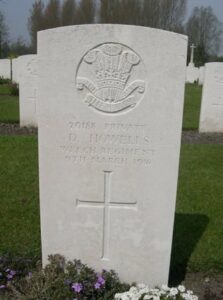
Rees Howells, Private, 28681, Border Regiment. Rees was the son of Thomas and Gwen Howells, of 2, Gwalia Villas, Penycae, Abercrave. He worked as a Collier prior to enlisting into the Army Service Corps at Pentre on 2 September 1914. Rees was posted to Aldershot but was discharged as medically unfit on 20 November 1914 as a result of the loss of most of his teeth and general poor health. He then re-enlisted into the King’s (Liverpool) Regiment before being posted to the 11th Battalion, Border Regiment. The battalion, known as the Lonsdales, was attached to 97 Brigade, 32nd Division and landed at Boulogne on 23 November 1915. It saw its first major action during the Somme Offensive of 1916, remaining in the sector over the winter before following up the German withdrawal to the Hindenburg Line in March 1917. The division moved to Ypres for a brief period in the summer of 1917 before being sent to the Flanders coast, near Coxyde and took up positions near Nieuport, south-west of Lombartzyde. At 06.00 on 10 July 1917 the battalion was hit by a fierce minenwerfer bombardment which cut off C and D Companies which were holding the front line. The bombardment continued for hours, causing such havoc that the battalion war diary of the day run to 15 pages, with detailed reports of messages being sent to and from HQ to the battalion outposts. Rees was posted as missing during the day, and some six months later was confirmed to have been believed to have been killed on 10 July 1917. The 28-year old has no known grave and is commemorated on the Nieuport Memorial, Belgium.
David Hughes, Private, 14762, South Wales Borderers. David was the son of John and Margaret Hughes, of Kidwelly. He married Mary Emily Musk at Seven Sisters in 1907, and the couple lived at 20, Bryndulais Row, Seven Sisters. David worked at the Yniscedwen Tinplate Works at Ystalyfera prior to the war, and enlisted at Ystradgynlais into the South Wales Borderers. He was posted to France on 11 December 1914, joining the 1st Battalion, South Wales Borderers, which was attached to 3 Brigade, 1st Division. It is not known when, but at some time later he transferred to the 2nd Battalion, South Wales Borderers. The battalion had begun their war in China, where they captured the German Garrison at Tientsin. The Battalion returned to England where they joined 87 Brigade, 29th Division. The Division moved to Gallipoli via Egypt, landing on 25 April 1915. They remained here until evacuation to Egypt on 11 January 1916, and then moved to the Western Front on 15 March 1916, taking up positions on the Somme, opposite Beaumont Hamel. David probably joined the battalion here, and was killed in action soon after, during the battalions first spell in the trenches. A relatively peaceful night was torn apart at 21.00 on 6 April 1916, when a box barrage fell to the rear of the trenches held by the battalion, and in the mayhem, their lines were attacked by a well-trained German raiding party. The 29th Division suffered a number of casualties during the raid, but embarrassment was caused by a large number of South Wales Borderers who were taken captive by the Germans. David was 30 years old when he was killed during the raid. He is buried in grave F. 6. in Mesnil Ridge Cemetery, Mesnil Martinsart, France. Two of his brothers also fell, Sam and Willie Hughes, and are commemorated in their native Kidwelly.
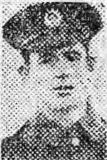
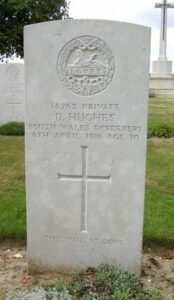
David Hughes, Private, 19019, South Wales Borderers. David was born in Llanwenog, Ceredigion in 1880. He married Dinah Matilda Evans, of Tenby Cottage, Llanybyther, in 1901 and the couple lived there until moving to Penycae, Ystradgynlais by 1911, where David worked as a stone mason. He enlisted at Ystradgynlais into the 5th Battalion, South Wales Borderers, which moved to France in July 1915 attached to 58 Brigade, 19th (Western) Division. The Division saw its first major action during the Battle of Loos on 25 September 1915, suffering heavy casualties for little effect. The Division moved to the Somme Sector in 1916, where they took part in the gallant capture of Ovillers-La Boisselle on 3 July 1916. David must have been wounded on the Somme and was evacuated back via the network of Casualty Clearing Stations and Hospitals in France, before being sent to Bowood Hospital, near Calne, Wiltshire. He died there of his wounds on 16 September 1916, aged 37, and is buried in Aberduar Welsh Baptist Chapelyard, Wales. David is not named on the Ystradgynlais Memorial, but there are two D. Griffiths named on there, one of whom is untraceable, so perhaps a mistake was made in the naming?

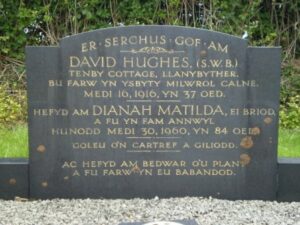
William Hull, Guardsman, 3492, Welsh Guards. William was the son of William and Anne Hull, of 7, Edwards Ville, Treharris. He lived and worked at Tynypant Farm, for his uncle, Gomer Davies, prior to the war, and enlisted into the Welsh Guards at Brecon. He was posted to France to join the 1st Battalion, Welsh Guards, which was attached to the 3rd Guards Brigade, Guards Division. The Welsh Guards had been formed by Royal Warrant on 26 February 1915, at White City, before landing at Le Havre on 18 August 1915, becoming attached to 3rd Guards Brigade, Guards Division. The Division saw its first major action during the Battle of Loos on 25 September 1915, remaining in the area during the coming months, where they also fought in the subsequent Action of Hohenzollern Redoubt. In July 1916 the Division moved to the Somme, where they fought at the Battle of Flers-Courcelette, and then at the Battle of Morval, capturing Lesboeufs Village. They moved to Flanders for the winter before taking up the line north of the 38th (Welsh) Division at Boesinghe, and from here took part in the Battle of Pilckem Ridge on 31 July 1917. The Guards Division was moved south to Cambrai later in the year in order to attempt to solidify the British line which had crumbled after early successes in the Battle of Cambrai had been reversed by a series of strong German counter-attacks and moved to positions near Gouzeaucourt. William was badly wounded during the re-capture of the village and died that same day, on 1 December 1917. The 20-year-old was buried in grave VI. C. 4. in Rocquigny-Equancourt Road British Cemetery, Manancourt, France.
W. Hunt. This man cannot presently be identified.
John James, Private, 93969, Royal Welsh Fusiliers. John was the son of John and Mary Ann James, of Caerlan, Abercrave. He had originally enlisted at Brecon into the South Wales Borderers, but upon being sent to France in 1918 was transferred to the 16th Battalion, Royal Welsh Fusiliers, which was attached to 113 Brigade, 38th (Welsh) Division. He probably joined the battalion on the Somme, where it held the line at Aveluy Wood, facing Thiepval Ridge. The division launched its assault across the flooded Ancre Valley on 21 August 1918, and assaulted Thiepval Ridge, before successfully capturing Pozieres and beginning its advance across the old Somme battlefields of 1916, as part of the great 100 days offensive. Over the coming weeks great swathes of land were recaptured from the Germans, and the Allies broke the Hindenburg Line at the end of September 1918, opening the doors to final victory. The 38th (Welsh) Division played an important part in this advance, and crossing through the Hindenburg Line began pursuing the enemy back towards the River Selle. John was killed in action while his battalion was advancing from Lempire towards La Terrière on 5 October 1918, the sole casualty of the battalion that day. The 21-year-old has no known grave and is commemorated on panel 6 of the Vis-en-Artois Memorial, Haucourt, France.
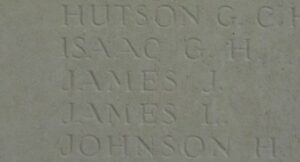
Tom Michael James, Private, 201101, South Wales Borderers. Tom was born in Treherbert in 1883, the son of John Llewelyn James and Sarah James. The family had moved to his fathers native Ystradgynlais by 1886 where John ran the Ship Inn. Tom married Catherine Mary Davies in 1905 and the couple lived in Star Cottage, Gough Buildings, Ystradgynlais. Some months after marrying, Tom was accused of attempted murder when a local gamekeeper was shot by a poacher, but he was later acquitted. He enlisted at Ystradgynlais into the Brecknock Battalion, South Wales Borderers, and embarked for India to join the battalion, which had moved there following service in Aden. Tom became ill and died in Mhow on 17 October 1918, aged 34. He is commemorated on face 5 of the Kirkee 1914-1918 Memorial, India.
Rice Jeffreys, Private, 27488, South Wales Borderers. Rice was the son of Rees and Margaret Jeffreys, of Penygraig, Colbren. He was a collier prior to enlisting at Brecon into the Brecknock Battalion, South Wales Borderers and after training was posted overseas in June 1916, joining the 4th Battalion, South Wales Borderers which was in Mesopotamia attached to 40 Brigade, 13th (Western) Division. The division had been sent from Egypt to Mesopotamia following service in Gallipoli as part of a force which had been built up to attempt to relieve the besieged garrison of the city of Kut. Following the fall of Kut on 29 April 1916 the Allies began an arduous campaign against the Turkish occupiers of the ancient country. Rice had only just received news that he was to return home after being granted a commission when he went missing in Mesopotamia on 20 December 1916. He was later officially recorded as having been killed in action on that date. The 23 year old has no known grave and is commemorated on panel 16 and 32 of the Basra Memorial, Iraq.
Charles Johns, Sapper, 108165, Royal Engineers. Charles was born in Crediton, Devon in 1889, the son of Robert and Elizabeth Johns. The family was living at The Firs, Ystradgynlais prior to the outbreak of war. Charles had served with the 6th Battalion, Devonshire Regiment (Territorials) prior to moving to Ystradgynlais. He re-enlisted at Ystalyfera into the 38th (Welsh) Division, Royal Engineers on 27 March 1915 and was posted to their 124th Field Company. He embarked for France with his unit on 3 December 1915. The 38th (Welsh) Division was initiated into trench warfare in the Fleurbaix area before moving to the Cuinchy sector and marched south to the Somme in June 1916. On 7 July 1916 the division launched its first assault against Mametz Wood, but was repulsed after suffering heavy losses and was re-organised before attacking again on 10 July. Charles was killed in action during the second assault on 10 July 1916 aged 26. He has no known grave and is commemorated on pier and face 8A and 8D of the Thiepval Memorial, France. Charles does not appear to be commemorated locally.
John Johnson, Shoeing Smith, 34506, Royal Field Artillery. John was born in Stourport, Worcestershire, the son of Isaac and Annie Johnson. He was an army reservist when he came to work at the Gwaunclawdd Colliery as a blacksmith some years prior to the war, lodging at Pantycwrt, Abercrave with Jane Joseph and her son Tom Rees Joseph. He was very well known locally, being one of the leading members of the local Boy Scouts troop. Upon the outbreak of war John re-joined the colours and embarked for France in August 1914 with the 119th Battery, Royal Field Artillery. He took part in the Battle of Mons on 23 August 1914 and was wounded during the overwhelming German attack on the British held city. John died of his wounds on the following day, 24 August 1914, aged 33. He has no known grave and is commemorated on the La Ferte-Sous-Jouarre Memorial, France.
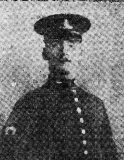
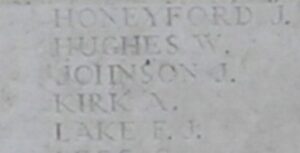
Albert Jones, Signalman, Wales/Z/3064, Royal Naval Volunteer Reserve. Albert was born on 11 December 1895, the son of Henry and Mary Ann Jones, of Gaigtredeg, Upper Cwmtwrch. He enlisted into the Royal Naval Volunteer Reserve and was posted aboard the destroyer HMS Laforey, which was attached to the Harwich Force. Laforey saw its first action during the Battle of Heligoland Bight, and on 23 January 1915, Took part in the Battle of Dogger Ban. Laforey then joined the 5th Destroyer Flotilla in the Mediterranean and helped to cover the evacuation from ANZAC Cove at the end of the Gallipoli Campaign. In February 1916 she re-joined the Harwich Force, and was sent out to escort the battleship HMS Marlborough which was returning to port with damage following the Battle of Jutland. On October 1916, Laforey was attached to the Dover Patrol and took part in several engagements over the coming months. On 23 March 1917 Laforey was escorting ships to France, and on her return journey exploded and broke in two after hitting a British-laid mine. She sunk quickly with the loss of almost 60 lives. Albert was 21 years old when he died that day, and is commemorated on panel 25 of the Plymouth Naval Memorial, Devon.
James Jones, Private, 94717, Machine Gun Corps. James was the son of Daniel and Elizabeth Jones, of 4, Temperance Hall, Oddfellows Street, Ystradgynlais. He had originally enlisted at Brecon into the Brecknockshire Battalion, South Wales Borderers on 8 June 1914 and had seen service in Aden with the battalion before it was posted to India. He returned home on 20 February 1918 and was posted out to France, joining the 74th Battalion, Machine Gun Corps, which moved to France following service in Palestine with the 74th (Yeomanry) Division. The division moved to Flanders to get used to Western Front conditions. James was killed in action while the division was holding the St. Floris sector when he was struck in the head by a bullet and killed on 7 August 1918. The 21-year-old is buried in grave IV. B. 1. in St. Venant-Robecq Road British Cemetery, Robecq, France.
Thomas Jones, Lance Serjeant, 22349, South Wales Borderers. Thomas was the son of Lewis John Jones and Mary Ann Jones, of Glantawe Row, Ystradgynlais. He married Grace Hughes in 1910 and the couple lived next to Thomas’s parents. Thomas enlisted at Ystradgynlais into the 11th Battalion, South Wales Borderers, which was training in North Wales prior to moving to Winchester as part of 115 Brigade, 38th (Welsh) Division. Thomas landed in France with the battalion on 2 December 1915 and the battalion moved to the Fleurbaix sector for trench initiation. The division then moved to the Cuinchy sector before marching south to the Somme in June 1916 and from 7 July 1916 began its assault on Mametz Wood. Following heavy losses during the capture of the wood, the division was moved to Hébuterne before being posted to the Boesinghe sector, north of Ypres, taking up positions along the canal bank. It remained here for the next twelve months before launching its offensive on the Pilckem Ridge on 31 July 1917. Thomas was killed in action during the offensive that day. The 25-year-old has no known grave and is commemorated on the addenda panel of the Ypres (Menin Gate) Memorial, Belgium.
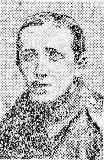
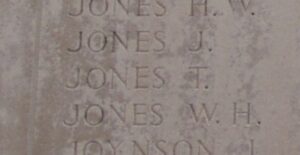
William John Jones, MM, Sergeant, 139041, Royal Engineers. William was the only son of John and Mary Jones, of the Castle Hotel, Abercrave. He worked at the International Colliery prior to the war and enlisted at Brecon into the South Wales Borderers. Upon arriving in France, William, due to his mining experience, was transferred to the 256th Tunnelling Company, Royal Engineers. This was a common occurrence among former colliers, as their skills were needed to fight a secret underground war, digging tunnels and bunkers to hold troops, or mines beneath the enemy which would be filled with the explosive Ammonal, to be detonated during large scale assaults in order to create gaps in the line for troops to break through. The 256th Tunnelling Company became posted to the large force which was gathering on the Flanders coast in readiness for a planned offensive towards Zeebrugge in the summer of 1917. William became wounded here, and died of his wounds on 28 August 1917, aged 25. He is buried in grave II. L. 11. in Coxyde Military Cemetery, Belgium. William had been awarded the Military Medal earlier in the war.
Harold Idris King, Private, 27780, South Wales Borderers. Harold was the son of Thomas and Caroline King, of Hazelhurst, Lower Cwmtwrch. He was a schoolteacher prior to the war and enlisted at Ystradgynlais into the Brecknock Battalion, South Wales Borderers. He embarked for overseas service in Aden with the Brecknocks, and afterwards transferred to the Devonshire Regiment, before being transferred to the 4th Battalion, South Wales Borderers. The battalion was attached to 40 Brigade, 13th (Western) Division in Mesopotamia. Harold was wounded during General Maude’s offensive towards the besieged city of Kut, in Mesopotamia. He died of his wounds on 19 February 1917, aged 21. Harold has no known grave and is commemorated on panel 16 and 62 of the Basra Memorial, Iraq.
Llewellyn Tibbett Lewis, Private, 58340, Welsh Regiment. Llewellyn was the son of Edward and Hannah Lewis, of 6, Susanah Street, Cwmtwrch. He worked as a collier and was living at Castle Street, Lower Cwmtwrch when he enlisted at Brecon into the 3rd Battalion, South Wales Borderers on 24 April 1918. On 3 August 1918 he embarked for France to join the 5th Battalion, South Wales Borderers, but was instead transferred to the 13th Battalion, Welsh Regiment (2nd Rhondda), which was attached to 114 Brigade, 38th (Welsh) Division. Llewellyn joined up with his new battalion during the advance of the 38th (Welsh) Division across the old Somme battlefields, which had been launched on 21 August 1918. The battalion helped capture Pozieres and Thiepval Ridge over the coming days before taking part in the 100 days offensive which took them past Mametz Wood and Delville Wood, before capturing Morval and Sailly-Saillisel. By 17 September the division had reached positions in front of the strongly defended village of Gouzeaucourt, which it had orders to assault and capture. At dawn on 18 September 1918 the division launched its assault, and the 13th Welsh attacked African and Heather Trenches. Heavy fighting continued over the coming days, but Llewellyn did not live to see the successful outcome of the attack, being killed in action on the first day. The 21-year-old has no known grave and is commemorated on the Vis-en-Artois Memorial, Haucourt, France.
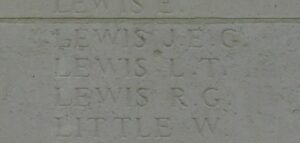
Willie Lewis, Private, 200660, South Wales Borderers. Willie was the son of William and Jane Lewis, of Pontrhydarw, Abercrave. He enlisted at Brecon into the Brecknockshire Battalion, South Wales Borderers, and embarked with the battalion at Southampton for overseas service in Aden on 3 December 1914 after two months of coastal defence duty at Pembroke Dock. The Brecknocks were under the command of Lord Glanusk and had been sent to counter the threat of Turkish forces in the region. Aggressive Turkish patrols led to the Brecknocks being sent to support the Sultan of Lahej as part of the Aden Movable Column. The hot and arid conditions took a heavy toll on the young troops and a number succumbed to heat stroke on the march. Willie was among those to suffer such a tragic end, dying of heat apoplexy on 10 July 1915, aged 19. He has no known grave and is commemorated on the Heliopolis (Aden) Memorial, Egypt. His parents later lived in Penycae Inn, Penycae, Abercrave.
John Lloyd, Private, 38216, Royal Welsh Fusiliers. John was the son of David and Elizabeth Lloyd, of Ynis Isaf, Ystradgynlais. He worked at Gwaunclawdd Colliery, Abercrave prior to enlisting at Brecon on 11 August 1914 into the South Wales Borderers but was then posted to the 2nd Garrison Battalion, Royal Welsh Fusiliers. On 6 March 1916 he embarked at Devonport for Alexandria with the battalion which moved to Zagazig, then to Cairo. On 12 July 1916 he embarked at Alexandria after being sent to join the BEF and was posted to the 2nd Battalion, Royal Welsh Fusiliers which was on the Somme attached to 19 Brigade, 33rd Division. The battalion had moved from the Cambrin sector to the Somme on 7 July 1916, and was itching for revenge against the Germans after the blowing of a mine beneath their positions at the Duck’s Bill some weeks earlier. The battalion moved into the front line near Bazentin-Le-Petit on 18 July and took part in heavy fighting over the coming days before moving back to Corbie for a rest. On 18 August the battalion marched back towards the front line from its billets and during the night took up positions below High Wood. On the following morning, 19 August 1918, John was killed while the battalion was relieving the 2nd Argyll’s at High Wood. The 25-year-old has no known grave and is commemorated on pier and face 4A of the Thiepval Memorial, France.
Patrick Maher, Private, 13291, South Wales Borderers. Patrick was from St. Finbarr’s, Cork. He married Martha Richards in 1911 and the couple lived at 22, Owen’s Lane, Godrergraig. He enlisted at Ystradgynlais into the 4th Battalion, South Wales Borderers and served at Gallipoli with the battalion after landing on 19 July 1915. Patrick must have been wounded or taken ill and invalided home as he transferred to the 1st Battalion, South Wales Borderers, which was in France attached to 3 Brigade, 1st Division. The division marched south from Loos to the Somme sector in July 1916 in order to take part in the Somme offensive, and fought alongside the Australians during the Battle of Pozieres, seeing heavy fighting at Munster Alley. Patrick was shot dead by a sniper while his battalion was in the trenches on 25 September 1916, aged 31. He has no known grave and is commemorated on pier and face 4A of the Thiepval Memorial, France.
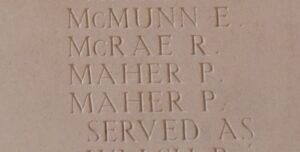
Arthur Mainwaring, Private, 22178, South Wales Borderers. Arthur was born in Cwmaman, the son of David and Ellen Mainwaring. The family later moved to 2, Temperance Buildings, Oddfellows Street, Ystradgynlais. Arthur enlisted with his brother Morgan at Ystradgynlais into the 11th Battalion, South Wales Borderers and trained in North Wales with the battalion before it moved to Winchester attached to 115 Brigade, 38th (Welsh) Division. He landed in France with the battalion on 4 December 1915 and served with it until being wounded at some time, most probably during the assault by 115 Brigade on Mametz Wood on 7 July 1916. After recuperating in hospital he returned home at the end of August 1916 and enjoyed a spell of sick leave before being posted back out to France joining the 6th Battalion, South Wales Borderers, which was the Pioneer Battalion to the 25th Division. The division fought at Messines Ridge and at Pilckem Ridge in 1917 and in the spring of 1918 was moved to the Arras sector to reinforce the line following the launching of the German offensive on the Somme. It was moved north to the Ploegsteert sector on the night of 30 March, but became caught up in the German offensive on the Lys, which was launched on 9 April 1918 and saw terrible fighting over the coming weeks. Arthur was wounded whilst working near La Clytte on 1 May 1918 and died of his wounds four days later, on 5 May 1918, aged 19. He is buried in grave II.C.4. in Arneke British Cemetery, France.
Albert Richard Mallows, Sapper, 199005, Royal Engineers. Albert was the son of George and Alice Mallows, of Glan-y-Dwr, Ystradgynlais. He worked at Seven Sisters and at the Ystradgynlais Colliery prior to enlisting at Ystalyfera into the 14th Battalion, Welsh Regiment (Swansea Pals), which was attached to 114 Brigade, 38th (Welsh) Division in February 1915 and embarked for France with the battalion on 3 December 1915. The battalion moved to the Fleurbaix sector for trench initiation before taking over the Cuinchy sector and while here a number of men with mining experience became attached to Tunnelling Companies of the Royal Engineers. Albert transferred to the 254th Tunnelling Company, Royal Engineers, and would have been present when Sapper Albert Hackett gained a posthumous Victoria Cross whilst attempting to rescue Private Thomas Collins, of the 14th Welsh, who had been trapped underground as the result of a German mine being blown on 22-23 June 1916. Albert later passed a course of instruction in mine rescue before the company moved to Ypres. He was badly wounded during the opening day of the Third Battle of Ypres on 31 July 1917 and died as a result of having a leg amputated on the following day, 1 August 1917, aged 21. Albert is buried in grave II.C.21. in Brandhoek New Military Cemetery No.3, Belgium. His brother James also fell.
James Charles Mallows, Private, 26230, Welsh Regiment. James was the son of George and Alice Mallows, of Glan-y-Dwr, Ystradgynlais. He married Daisy Florence Badham, while working as a haulier in Bromley, on 7 February 1903 and the couple had moved to Rose Villa, Abercrave by 1911, with their three children. James enlisted at Brecon into the 17th Battalion, Welsh Regiment, which was a Bantam battalion attached to 119 Brigade, 40th (Bantam) Division. The Division moved to France during the first week of June 1916, and moved to the front near Loos. Late in 1916 it moved south to the Somme, and fought at the Battle of the Ancre, remaining in the area over the winter. In March 1917 the Germans withdrew to the Hindenburg Line, and the 40th Division followed the withdrawal. Later in the year it took part in the Battle of Cambrai, playing an important role in the attack on Bourlon Wood. James was later transferred to the 13th Battalion, Welsh Regiment (2nd Rhondda), which was attached to 114 Brigade, 38th (Welsh) Division and probably joined the division on the Somme, in the Aveluy Wood sector, in the spring of 1918. On 21 August 1918 elements of the division crossed the flooded Ancre valley before assaulting Thiepval Ridge, beginning the divisions part in the great 100 days offensive which followed. During the coming days the Germans were driven back across the old Somme battlefields of 1916 and by the end of August had reached the fortified village of Morval. On the morning of 1 September 1918, the 13th Welsh took part in the assault of 114 Brigade on trenches to the east of Morval and despite heavy machine-gun fire, completed the capture of their objectives by 06.00. James had been killed during the attack that morning. The 33-year-old has no known grave and is commemorated on panel 7 of the Vis-en-Artois Memorial, Haucourt, France. His brother, Albert Richard Mallows, also fell.
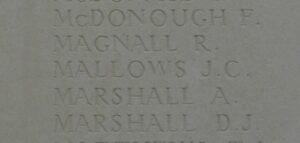
Sydney Neale Marsden, Sergeant, 14618, South Wales Borderers. Sydney was the son of William and Kate Marsden, of Rotherham. He was an army reservist, and worked as a carpenter when he married Ellen Mead in 1909. The couple were living at Gilwen Cottage, Lower Cwmtwrch by 1911, where their son and two daughters were born. Sydney re-joined the colours at the outbreak of war and landed in France on 29 November 1914, joining the 1st Battalion, South Wales Borderers, which was at Ypres attached to 3 Brigade, 1st Division. Sydney probably saw action at Ypres, during the Battle of Aubers Ridge the following year. He was later transferred to the 5th Battalion, South Wales Borderers, which landed in France on 16 July 1915 as the Pioneer battalion to the 19th (Western) Division. The battalion spent most of September 1915 stationed at Gorre, preparing for its part in a planned assault by the 19th Division on the German lines north of Loos, near Givenchy, as a diversionary attack for the main offensive at Loos on 25 September 1915. The division suffered terrible casualties during a fruitless charge at Givenchy that day and remained in the same area while the main Loos battle raged on to their south. The 5th SWB continued its work, mainly around Le Touret, during the following weeks. Sydney was killed in action here on 29 October 1915 whilst on a working party at Gorre. The 30-year-old is buried in grave I.G.6. in Brown’s Road Military Cemetery, Festubert, France. His only son, Sidney Neale Marsden, was killed in action in Normandy on 11 July 1944.
Joseph Henry Marshall, Private, 18264, South Wales Borderers. Joseph was the son of George and Mary Anne Marshall, of Newcastle-under-Lyne, Staffordshire. By 1911 he was working at Ystalyfera and lodged at Church Road, Godrergraig. He enlisted at Ystradgynlais into the 5th Battalion, South Wales Borderers, which was attached to 58 Brigade, 19th (Western) Division and landed in France with the battalion on 17 July 1915. The Division took part in the opening attack of the Battle of Loos on 25 September 1915, suffering heavy casualties for no gain. The following year the Division moved to the Somme, where it took part in the second wave of the attack on Ovillers-La Boisselle on 1 July, capturing the village at heavy cost. It then fought through the Somme Battles of Pozieres and the Ancre in 1916. The division wintered on the Somme, and the 5th SWB carried out a lot of work in the Hébuterne area, tunnelling and digging trenches and mine shafts. On 28 January 1917 the battalion was at work constructing an ammunition dump and a tramway in Hébuterne when Joseph was reported to have died of natural causes due to the terrible weather conditions. He was 32 years old and is buried in grave II.J.10. in Sailly-Au-Bois Military Cemetery, France.
Andalusia Martin. Andalusia was a Spaniard, who had been born in 1887. He reported lived at 2, Davies Street, Abercrave and later at Wind Road, Ystradgynlais. Nothing more is currently known of him.
Harold Martin, Driver, 67486, Royal Engineers. Harold was born in Great Bowden, Leicestershire, the son of James and Ann Martin. By 1911 the family had moved to Crofton House, Lower Cwmtwrch, where his father had gained a position in the council, and young Harold began working underground as a miner. Harold enlisted at Ystalyfera into the 38th (Welsh) Division Royal Engineers and was attached to their 151st Field Company. The division was initiated into trench warfare near Armentieres, in the Fleurbaix sector alongside the 19th Division, before holding the line in various sectors down as far as Cuinchy over the coming months. By July 1916 the division had moved south to the Somme and took part in the famous assault on Mametz Wood. It was then moved to positions at Boesinghe, north of Ypres, where it spent almost a year before taking part in the famous assault on Pilckem Ridge on 31 July 1917. The division wintered back in the Armentieres sector, and moved back to the Somme at the end of March 1918 to hold the line north of Albert, overlooking the Ancre and Aveluy Wood. From 21 August 1918 the division began its part in the great 100 days offensive, which ultimately broke the Hindenburg Line and won the war. Harold survived all of these great battles, but took ill towards the end of the war, and died in hospital in France on 5 November 1918, aged 21. He is buried in grave XIII.N.1B. in Mont Huon Military Cemetery, Le Treport, France.
Hopkin Morgan, Driver, T/260798, Army Service Corps. Hopkin was the second son of William and Margaret Morgan, of Danygraig, Abercrave. He was a manager at a grocery shop at Caerlan prior to enlisting on 2 January 1917 into the Army Service Corps and was posted to the 2nd Cyclist Brigade at Cromer, on the Norfolk coast. He became ill during training in Norfolk, as a result of exposure during training and was hospitalised at Norwich before being discharged from the army as unfit on 25 July 1917 after being diagnosed as suffering from pericarditis. He returned home to Abercrave where he died on 16 January 1918, aged 24. He was buried in Ty Ny Coed Congregational Chapelyard, Abercrave. Hopkin is not commemorated by the Commonwealth War Graves Commission.
Richard Morgan, Private, 17887, Welsh Regiment. Richard was the son of John Morgan and Mary Ann Morgan, of Ystradgynlais. He lived with his grandmother, Ann Hopkins, at Cefn Coed Uchaf, Abercrave following the death of his father in 1899 before moving in with his sister Mrs Margaret Jones, at Bryncolyn House, Colbren by 1911. Richard was lodging with Thomas Hopkins at The Miners Arms, Ystradgynlais when he enlisted at Swansea into the 14th Battalion, Welsh Regiment (Swansea Pals), which trained in Rhyl and Winchester before embarking for France with 114 Brigade, 38th (Welsh) Division on 3 December 1915. The battalion moved to the Fleurbaix sector for trench initiation and by 8 February 1916 was in reserve in the Richebourg sector. Richard was among a small number of men wounded in the trenches on 20 and 21 February 1916. He died of his wounds on 21 February 1916 aged 24 and is buried in grave I.C.8. in Vieille-Chapelle New Military Cemetery, Lacouture, France. His half-brother Thomas John Morgan also fell.
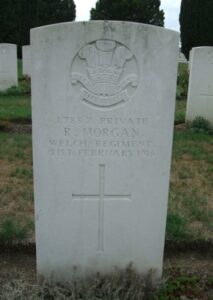
Thomas Morgan, MM, Sergeant, 14735, South Wales Borderers. Thomas was the son of David and Ann Morgan, of Victoria Street, Llandovery. He worked at the International Colliery and lodged with Mr and Mrs Jenkins at Clydfau, Station Road, Abercrave, and was a well-known hockey player prior to the war. Thomas enlisted at Brecon into the 1st Battalion, South Wales Borderers. The Battalion had landed at Havre on 13 August 1914, as part of 3 Brigade, 1st Division, and took part in the retreat from Mons to the Marne, before moving to Ypres, where they fought at First Ypres, and then at Aubers in early 1915. They took part in the Battle of Loos in September that year, and in 1916 fought on the Somme, from the Battle of Albert in July onwards, and were on the Ancre over the winter of 1916/17 and took part in the push to the Hindenburg Line in March 1917, before being posted to the Flanders Coast. They were rushed south to take part in Third Ypres. It was here, during the Second Battle of Passchendaele, that Thomas was wounded. He died of wounds on 10 November 1917 aged 28. He is remembered on the Tyne Cot Memorial, Belgium. Thomas was the holder of the Military Medal.
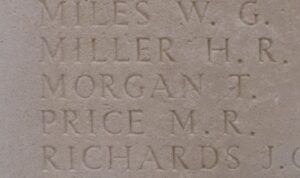
Thomas John Morgan, Gunner, 259754, Royal Field Artillery. Thomas was the son of John Morgan and Ann Morgan, of Ystradgynlais. He lived with his grandmother, Ann Hopkins, at Cefn Coed Uchaf, Abercrave following the death of his father in 1899. Thomas enlisted at Brecon into the Royal Field Artillery and was posted to France to join the 21st Battery, Royal Field Artillery. Thomas was killed in action during the 100 days offensive, on 17 October 1918. The 21-year-old was buried in III. C. 4. in Busigny Communal Cemetery Extension, France. His half-brother Richard Morgan also fell.
George Mountjoy, Private, 6482, Welsh Regiment. George was the son of William and Mary Ann Mountjoy, of Westleigh, Bideford, Devon. He was an army reservist, and after leaving the colours work brought him to west Wales, and he took up a gardening position in Blackpill, near Swansea, before moving to Abercrave, where he married Ethel Watts. George re-joined the 2nd Battalion, Welsh Regiment at Cardiff following the declaration of war. The battalion embarked for France attached to 3 Brigade, 1st Division, and landed on 14 August 1914 before entraining for Mons. The division took part in the epic retreat from Mons to the Marne, before taking part in a series of battles on the Marne and drove the Germans back over the River Aisne, where William Fuller of the 2nd Welsh won the first Welsh VC of the war. The division then moved to assist the defence of the Belgian city of Ypres, taking up positions along the Menin Road, where it saw heavy fighting in the First Battle of Ypres. George was taken prisoner at some time, probably at Ypres, and was held in a POW camp in Germany, where he died on 6 April 1915, aged 33. George is buried in Berlin South-Western Cemetery, Germany.
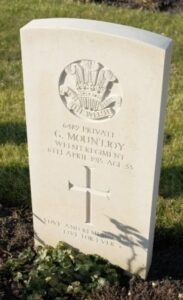
Arthur Palmer, Private, 18782, South Wales Borderers. Arthur was the husband of Ada Palmer, of 8, Gadds Green, Oakham, Dudley, Staffs. He worked as a coal hewer prior to the war and lodged at 7, Brookland Terrace Abercrave. He enlisted at Ystradgynlais into the 3rd Battalion, South Wales Borderers, and was posted to the 2nd Battalion, South Wales Borderers following their triumphant return from China in January 1915. The battalion entrained for Rugby to join 87 Brigade, 29th Division and sailed with the division from Avonmouth on 17 March 1915 for Egypt. On 25 April 1915 the division landed at Cape Helles, Gallipoli, and saw heavy fighting during the campaign before being evacuated to Egypt on 11 January 1916 and then moved to the Western Front on 15 March 1916. The division moved to the Somme sector, taking the line opposite Beaumont Hamel, and from here launched its assault against Y-Ravine on 1 July 1916, the opening day of the Somme offensive. At 06.20 the signal was sounded for the advance to begin. The Borderers leaped from their trenches and began the advance, but within some 200 yards German machine-guns had wiped out most of the attacking force. Arthur was 30 years old when he was killed during the advance on Y-Ravine that day. He is buried in grave D.37 in Y Ravine Cemetery, Beaumont-Hamel, France.
Frank Phibben, Private, 27786, King’s Shropshire Light Infantry. Frank was born in Westbury, Wiltshire in 1890, the son of Eli and Elizabeth Phibben. He was living at Merthyr by 1910 and married Mary Margaret Williams there on 12 September 1910. By the outbreak of the war the family was residing in 6, Watkins Terrace, Caerbont, Abercrave. Frank enlisted at Aberdare on 1 September 1914 into the 9th Battalion, Welsh Regiment, but was discharged as physically unfit on 21 October. He re-enlisted at Swansea into the 5th Battalion, Wiltshire Regiment, which was attached to 40 Brigade, 13th (Western) Division and landed at Gallipoli with the battalion on 5 September 1915. Upon its evacuation from Gallipoli in January 1916 the division moved to Egypt and the following month was sent to Mesopotamia. Frank left the battalion at some time and was posted to France, joining the 6th Battalion, Wiltshire Regiment. He was transferred at some time into the 7th Battalion, King’s Shropshire Light Infantry, which was attached to 8 Brigade, 25th Division. The division was rushed to the Arras sector following the launching of the German spring offensive of 21 March 1918 and nine days later moved to the Ploegsteert sector. It became caught up in heavy fighting following the launch of the Germans Lys offensive on 9 April 1918 and took part in the fighting withdrawal to the west. Frank was killed in action near Kemmel on 22 April 1918 aged 28. He has no known grave and is commemorated on panel 98-99 of the Loos Memorial, France.
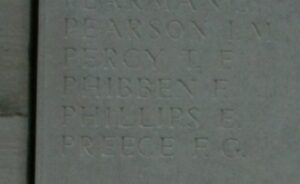
Matthew Powell, Sergeant, 6649, Welsh Regiment. Matthew was the son of Robert William Powell and Mary Powell, of Shoreditch. He had moved to Cwmtwrch to work as a collier at Rhosamman Colliery, and married Esther Frances Martin there in 1910. The couple lived at Old Lamb, Upper Cwmtwrch with their two children. Matthew was an army reservist who landed in France on 10 November 1914, joining the 2nd Battalion, Welsh Regiment, which was at Ypres, attached to 3 Brigade, 1st Division. The battalion had suffered grievous casualties during its time at the front, taking part in the retreat from Mons to the Marne, and then in a famous assault on Chivy Ridge during the Battle of the Aisne, before moving to Ypres, and helping stop the German assault on the ancient city. Matthew probably served with the 2nd Welsh during the Battle of Aubers Ridge the following year, and was most likely with the battalion during the Battle of Loos, where it again suffered heavy losses. At some time he was transferred out to the Middle East, joining the 8th Battalion, Welsh Regiment, which had moved from Gallipoli to Egypt, before being despatched to Mesopotamia with the 13th Division. Matthew became ill and died of pneumonia aboard the Hospital Ship Dongola on 20 July 1916, aged 36. He was buried at sea, and as a result is commemorated on panel 24 of the Basra Memorial, Iraq.
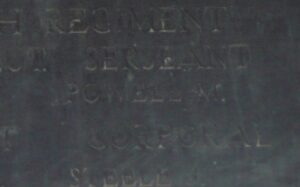
William James Powell, Private, 49363, South Wales Borderers. William was the son of William John and Elizabeth Powell, of Ystradgynlais. He married Mary Blodwen Phillips, of 45, Neville Street, Cardiff, in 1916. William was a collier before he enlisted at Ystradgynlais into the South Wales Borderers in March 1918 and was posted to France, joining the 10th Battalion, South Wales Borderers, which was attached to 115 Brigade, 38th (Welsh) Division. By the time William joined the battalion the division was advancing across the old Somme battlefields, having launched an offensive across the River Ancre on 21 August 1918 and had made impressive progress while advancing towards the Hindenburg line. Following the breaking of the Hindenburg Line on 29 September 1918 the division took part in the drive past Le Cateau towards the frontier and by 19 October 1918 had reached Troisvilles, where it billeted for several days. It re-joined the offensive around the town of Forest on 23 October, taking part in the Battle of the Selle, where the division crossed the River Selle under heavy fire and reached the village of Englefontaine, on the edge of the Forest of Mormal. William was killed in action near Englefontaine on 29 October 1918, aged 26. He is buried in grave VIII.B.14. in Romeries Communal Cemetery Extension, France.
Emlyn Morgan Rees, Sapper, 146064, Royal Engineers. Emlyn was born in Victoria, Australia, on 9 August 1892, the son of Morgan and Mary Anne Rees. By the turn of the century the couple had moved back to Wales and settled at 4, Cambrian Place, Upper Cwmtwrch, then later at Bryncelyn, Rhiwfawr, Lower Cwmtwrch. Emlyn worked as a coal miner prior to enlisting into the Brecknock Battalion, South Wales Borderers on 10 October 1914. On 25 January 1916 he transferred to the Royal Engineers and was posted as a tunneller’s mate to the 252nd Tunnelling Company, Royal Engineers. During his first months in France he rose to the rank of Sergeant, while his unit carried out the secretive work of constructing underground mines and dugouts, and was the unit responsible for the construction of the Hawthorne Ridge mine, which was filmed exploding on the opening day of the Battle of the Somme. On 6 August 1917 he was reduced to Sapper for inefficiency. Early in 1918 the company moved from the Beaumont Hamel area to positions at Vimy, where it became attached to the 172nd Tunnelling Company, and became caught up in the German offensive of 21 March 1918, being engaged in defensive mining operations and facing the attack near Boursies. Emlyn was wounded during this terrible period, and died of his wounds at Doullens on 26 March 1918, aged 26. He is buried in grave V.D.30. in Doullens Communal Cemetery Extension No. 1, France.
Alfred Richards, Private, 57474, Suffolk Regiment. Alfred was the son of John and Lydia Richards, of 6, Hendrelas Terrace, Brecon Road, Ystradgynlais. He originally enlisted into the Army Service Corps at Neath and landed in France on 18 December 1915. He was later transferred to the infantry, firstly with the 10th Battalion, Northumberland Fusiliers and then to the 12th Battalion, Suffolk Regiment. He probably joined the Suffolks following a spell in hospital in England during December 1917 and was home on leave in Ystradgynlais in January 1918. The 12th Battalion, Suffolk Regiment had been decimated in the spring of 1918 and was rebuilt in England before being sent back to France on 5 July 1918, attached to 43 Brigade, 14th (Light) Division. The division moved to the Ypres Salient in order to take part in the great advance. On 11 September 1918 the battalion began moving towards the front line from billets north-west of Vlamertinghe and took up positions in the Bluff-Canal Sector. Alfred was killed in action here on 28 September 1918, aged 27. He has no known grave and is commemorated on panel 40 to 41 of the Tyne Cot Memorial, Belgium.
Isaac Roberts, Private, 48589, Royal Army Medical Corps. Isaac was the son of Mrs Deborah Thomas, of 5, Beckett Street, Mountain Ash. He married Rachel Roberts in 1910 and the couple resided in 22, College Row, Ystradgynlais. He worked as a coal hewer prior to enlisting into the 130th (St. John’s) Field Ambulance, Royal Army Medical Corps, which landed in France on 4 December 1915 attached to the 38th (Welsh) Division. Isaac would have been present when the division assaulted Mametz Wood in July 1916 and also at Pilckem Ridge in July to August 1917 before being posted to the St. John’s Ambulance Brigade Hospital at Étaples. He was based here when he was killed during an air raid on 1 June 1918, aged 35. He is buried in grave LXV.E.16. in Étaples Military Cemetery, France.
Harry Rowe, Private, 28609, North Staffordshire Regiment. Harry was the son of Frederick and Elizabeth Rowe, of Broseley, Shropshire. He lived at Ystradgynlais prior to the war and enlisted at Gurnos into the King’s Shropshire Light Infantry, before being transferred to the 1st Battalion, North Staffordshire Regiment. He probably joined the battalion in France in 1916 by which time it had become attached to 72 Brigade, 24th Division. The division took part in the Somme offensive, fighting at Delville Wood and Guillemont, before moving north of Arras in early 1917 and fought at the Battle of Vimy, alongside the Canadian Corps. During June the division moved to positions south of Ypres, where it took part the Battle of Messines. After the successful capture of Messines Ridge, the Division moved further north, and fought at the Battle of Pilckem Ridge. Harry was killed in action during the opening day of the battle, on 31 July 1917, aged 39. He has no known grave and is commemorated on panel 55 of the Ypres (Menin Gate) Memorial, Belgium. Harry does not appear to be commemorated locally.
Fred Russell, Private, 27811, South Wales Borderers. Fred was the son of Harry and Annie Russell, of Brecon. Following the death of their mother, Fred and his brother Arnold lodged with Rees Jones at Brecon before Fred enlisted into the South Wales Borderers. Prior to the war Fred had left the army and was lodging with his sister, Mrs William Williams, at 11, Church Terrace, Ystradgynlais. He re-enlisted at Llanfaes soon after the outbreak of war, Joining the Brecknock Battalion, South Wales Borderers. He was temporarily transferred to the 6th Battalion, Devonshire Regiment. Both the Brecknocks and the 6th Devons were sent to the Middle East early in the war, the former to Aden and the latter to India and newspaper reports state that Fred embarked with the Brecknocks in October 1914, however his surviving records state that he embarked for India on 3 July 1915. He was then posted to the 4th Battalion, South Wales Borderers, which was attached to 40 Brigade, 13th (Western) Division and fought with the battalion in Mesopotamia. Fred was killed in action in Mesopotamia on 30 April 1917, aged 30. He has no known grave and is commemorated on panel 16 and 62 of the Basra Memorial, Iraq.
David John Samuel, Corporal, 290469, Welsh Regiment. David was the son of Thomas Samuel and Rachel Samuel (nee Davies), of Penybryn, Abercrave. He worked as a clerk at Abergavenny prior to the war and enlisted at Brecon into the 7th Battalion, Welsh Regiment. The 7th Welsh was a Cyclist battalion and remained on home service for the duration of the war as part of the Tees Garrison. David was serving on the garrison when he was taken ill and found to be suffering from pneumonia. He was taken to hospital at Hartlepool where he died on 17 July 1918, aged 24. His body was brought home and David was buried in Carmel Calvinistic Methodist Chapelyard, Abercrave. For many years he remained forgotten by the Commonwealth War Graves Commission, until he was recently accepted for commemoration by them, and his name was added to the Brookwood (United Kingdom 1914-1918) Memorial, Hampshire.
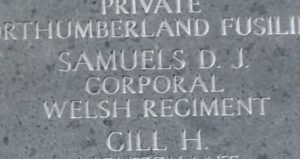
Richard Reginald Rees Taylor, Private, 125797, Machine Gun Corps. Richard, known as Reginald, was the son of William and Annie Taylor, of 6 Midland Terrace, Lower Cwmtwrch. He enlisted at Brecon into the Monmouthshire Regiment, and was posted to France, joining the 51st Battalion, Machine Gun Corps, which formed on 19 February 1918, attached to the 51st (Highland) Division. The division was in positions near Flesquières when Reginald joined it and was hit hard by the German offensive of 21 March 1918. The battered division was moved to Bethune to rebuild and rest, but was caught up in another offensive, the Battle of the Lys, which was launched on 9 April 1918, and saw heavy fighting around Richebourg Saint-Vaast. At the beginning of May, the Division moved to Oppy near Arras, where it stayed until 11 July, but following another German offensive to the south, the Battle of the Aisne, was sent to assist the beleaguered divisions there. Reginald was killed in action on the Aisne on 28 July 1918, aged 20. He has no known grave and is commemorated on the Soissons Memorial, France.
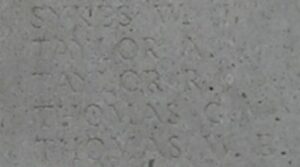
David Oswald Thomas, Private, 38555, Gloucestershire Regiment. David was the son of George and Margret Thomas, of Nantcae’refail, Penycae. He was a Theology student at Lampeter College prior to the war, but left there to enlist into the South Wales Borderers at Brecon and served in Ireland for a time. David was posted to France, probably early in 1918, and was transferred to the 12th Battalion, Gloucestershire Regiment, known as ‘Bristol’s Own’, and was attached to 95 Brigade, 5th Division. The division had been in Italy but was hurriedly recalled to France following the German offensive of 21 March 1918, and moved to positions on the Franco-Belgian border. It played an important part in the Battle of Hazebrouck, especially in the Defence of Nieppe Forest, following the Germans secondary offensive, on the Lys, which was launched on 9 April 1918. On 5 June 1918 the battalion was in a rest area behind the lines when a German shell crashed in their area, killing six men and wounding several others. David, who was 19 years old when he was killed by the shell explosion, is buried in row B, grave 12, in Thiennes British Cemetery, France, alongside his comrades.
O. Thomas. This man cannot presently be identified.
P. Thomas. This man cannot presently be identified.
Thomas Thomas, Private, 12019, South Wales Borderers. Thomas was the son of Thomas and Elizabeth Thomas, of Sennybridge. He worked as a postman at Abercrave prior to the war. Thomas married Edith Jane Thomas in 1909 and the couple lived at Glaslyn, Abercrave, where their two children were born. Thomas enlisted at Swansea into the 1st Battalion, South Wales Borderers, and joined the battalion in France at some time in 1916. The battalion was attached to 3 Brigade, 1st Division and moved south to the Somme sector from Loos in July 1916 in order to take part in the Somme offensive. The division saw heavy fighting on the Somme, especially around the OG Lines and Munster Alley during the Battle of Pozieres. The division followed the German retreat to the Hindenburg Line in early 1917, and then moved to Coxyde, on the Flanders Coast, where forces had begun building up in the eventuality of an assault northwards towards Zeebrugge. This plan was called off as a result of the stalling of the Third Battle of Ypres, and at the end of October the division moved to support the offensive towards Passchendaele Ridge. On 8 November 1917 the 1st South Wales Borderers began moving to the front line from Poperinge, and took up positions at Valour Farm on 9 November, where it formed in readiness for a forthcoming assault. Detailed orders were issued to the battalion’s officers, detailing the disposition of troops and the objectives for each company, and also detailed a number of pill-boxes which needed to be over-run, a daunting task in this now marsh-like battlefield. On the morning of 10 November 1917, the Borderers went over the top and launched their attack, walking into their own barrage. Heavy fighting raged during the day, with the battalion being forced to beat off a series of German counter-attacks. Thomas was killed at some time during the action that day. The 32-year old was posted as missing, and it was 11 months later that he was adjudged to have been presumed killed. Thomas has no known grave and is commemorated on panel 66 of the Tyne Cot Memorial, Belgium.
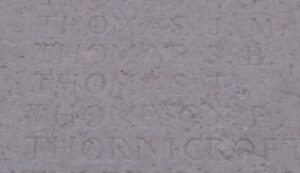
David Tyler, Private, 57046, Welsh Regiment. David was the only son of Frank Tyler and Olivia Tyler (nee Lewis), of Seagery House, Abercrave. He worked as a coalminer prior to enlisting into the Glamorgan Yeomanry at Bridgend on 21 October 1915. On 4 August 1916 David was posted to the Welsh Regiment Depot in France and a week later was posted to the 14th Battalion, Welsh Regiment (Swansea Pals), which was attached to 114 Brigade, 38th (Welsh) Division. The division had taken a mauling at Mametz Wood between 7 and 11 July 1916 and after a brief period at Hébuterne moved to positions north of Ypres, along the bank of the Yser Canal at Boesinghe. The division remained here for twelve months, taking part in the launching of the Third Battle of Ypres, when it assaulted the Pilckem Ridge on 31 July 1917, capturing all its objectives. 114 Brigade remained in the line for several days after the initial battle, and on 5 August 1917 the 14th Welsh moved forwards to take up the line west of the Steenbeek stream. David was killed in action during the day. The 21-year-old was originally buried on the battlefield, alongside other Welsh soldiers, but in 1920 their graves were exhumed and David was re-interred in grave XXV. D. 13. in New Irish Farm Cemetery, Belgium.
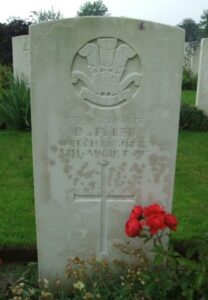
Oswald Watkins, Private, 26524, Welsh Regiment. Oswald was the son of Morgan and Ann Watkins, of Caerbont, Abercrave. He worked at the Gwaunclawdd Colliery prior to enlisting at Ystradgynlais into the Welsh Regiment and was posted to France on 15 April 1915, joining the 2nd Battalion, Welsh Regiment, which was attached to 3 Brigade, 1st Division. Oswald saw his first major action when the 1st Division took part in the Battle of Aubers Ridge, which saw the entire division, especially the 2nd Welsh, suffer heavy casualties. Its next major action was at the Battle of Loos, which was launched on 25 September 1915. On the opening day of the battle the 1st Division was in support of the 47th Division and the 15th (Scottish) Division, but failed to advance as the British gas cloud blew back over the advancing troops, causing chaos. The 1st Brigade managed to achieve some ground, but the 2nd Brigade became held up and were attacked in the flank by the Germans. The 2nd Welsh, with 3 Brigade, were ordered to move to the north to support 1 Brigade in its attack on Hulluch and the 2nd Welsh broke through the German lines at Lone Tree. The situation had by now become chaotic and the men spent a cold wet night on the battlefield, suffering intermittent shell and machine-gun fire. Heavy fighting continued the following morning, of 26 September 1915, and the 2nd Welsh came under very heavy fire. Oswald was killed on this, the second day of the battle. The 20-year-old has no known grave and is commemorated on panel 78 of the Loos Memorial, France.
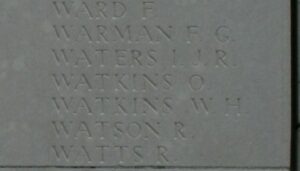
Cornelius Samuel White, Private, 16/1801, Royal Warwickshire Regiment. Cornelius was born in Dorset in 1897, the son of Jarvis and Amelia Elizabeth White. Following the death of Amelia in 1900 the family became split up and Cornelius was raised in Mullers House children’s home in Bristol before moving to Ystradgynlais, where he lodged and worked for John and Mary Bowen. He enlisted at Birmingham along with his brother Frederick into the 16th Battalion, Royal Warwickshire Regiment, which was attached to 95 Brigade, 32nd Division. The battalion landed at Boulogne on 21 November 1915 and the following month transferred to 15 Brigade, 5th Division. The division moved to the hostile Vimy sector, where it remained until moving to the Somme, taking part in several actions before being moved to Festubert to rest. In March 1917 the division moved south and took part in the Battle of Arras, remaining here before moving north on 7 September 1917, to take part in the Third Battle of Ypres. Cornelius was killed near Ypres, during the opening day of the Battle of Poelcapelle, on 9 October 1917, aged 21. He has no known grave and is commemorated on panel 23 to 28 on the Tyne Cot Memorial, Belgium. His brother Frederick was killed at Ypres just weeks later, on 28 October, while an elder brother, William Jarvis White, had been killed at Gallipoli on 19 August 1915.
James George Whiting, MM, Lance Corporal, 7080, Wiltshire Regiment. James was the son of Frederick Henry Whiting, of Queen Street, Chedworth, Gloucester. He lived at Gamlas Cottage, Abercrave prior to enlisting at Devizes into the 1st Battalion, Wiltshire Regiment. The battalion landed at Rouen on 14 August 1914 attached to 7 Brigade, 3rd Division and took part in the Battle of Mons and the epic retreat south to the Marne. Following the battles of the Marne and the Aisne, which prevented the German break-through to Paris, the division moved to the Messines sector, seeing heavy fighting there before becoming involved in the famous Christmas Truce that year. At some time after James transferred to the 2nd Battalion, Wiltshire Regiment, either after having been wounded or being ill. The battalion was attached to 21 Brigade, 7th Division and had landed at Zeebrugge on 7 October 1914, taking part in fierce fighting during its withdrawal to Ypres. Both the 1st and 2nd Battalions of the Wiltshire Regiment saw heavy fighting during the war, but by the beginning of 1917 James was with the 2nd Battalion, which was by then attached to 21 Brigade, 30th Division. The division had followed the German withdrawal to the Hindenburg Line in March 1917 and in April too part in the First Battle of the Scarpe, in the Arras sector. James, who had by now been awarded the Military Medal, was killed in action here on 9 April 1917. The 30-year-old is buried in grave VI. E. 24. In Wancourt British Cemetery, France.
Arthur Williams, Corporal, 13/664, East Yorkshire Regiment. Arthur was the son of Thomas Richard Williams and Rachel Williams, of Granville Gardens, Jesmond, Newcastle-on-Tyne. His father was from Ystradgynlais and was a School Inspector at Hull. Arthur worked as a clerk prior to the war and enlisted alongside one of his brothers, Evan Clifford Williams, into the 13th Battalion, East Yorkshire Regiment on 21 November 1914. On 15 December 1915 Arthur was posted to Egypt with the battalion, which was attached to 92 Brigade, 31st Division. By now the Gallipoli peninsula was being evacuated, so the division embarked at Suez for France in March 1916. The division moved to the Somme sector and took part in the assault on Serre on 1 July 1916, suffering very high casualties. It was withdrawn for several months as a result. They moved back into the line on 12 November 1916 following a spell of training at Warnimont Wood and on 13 November 1916 attacked the German lines in the northern Somme sector, in front of Coigneux. After a day of heavy fighting, Arthur’s battalion was relieved and moved to billets in Rossignol Farm where it remained for the coming days. Arthur was posted as missing during the attack and is somehow now officially recorded as having been killed in action on 16 November 1916, aged 19, two days after his battalion moved out of the line. He was reportedly killed after taking over command of his platoon and being killed when a shell fragment struck him in the head. Arthur is buried in grave III.E.12. in Douchy-Les-Ayette British Cemetery, France.
J. Williams. This man cannot presently be identified.
Johnny Williams, Private, 58489, South Wales Borderers. Johnny was the son of Daniel and Mary Williams, of Brythonfa, Gwilym Road, Cwmllynfell. He married Mary Hannah Rees, of Cefn-Coed View, Upper Cwmtwrch, early in 1918 prior to enlisting at Cardiff into the 3rd Battalion, South Wales Borderers after being called up. He was posted to France soon afterwards, joining the 5th Battalion, South Wales Borderers, which was attached to 58 Brigade, 19th (Western) Division. He probably joined the battalion following its ordeals following the German offensives of 21 March 1918, on the Somme, and 9 April 1918, on the Lys, when the 19th Division was unfortunate to have been caught up in two separate battles. The battered division moved to the Aisne sector to rebuild after being evacuated from the Messines area from 14 May, but got caught up in the Germans third, and final, large scale offensive of 1918, when they attacked the British and French lines in the Aisne and Champagne sectors. The division suffered terribly again and did not see further action until taking part in the 100 days offensive, which was launched on 21 August 1918. Johnny was killed in action during the advance past Cambrai on 15 October 1918. The 22-year-old has no known grave, and is commemorated on panel 6 of the Vis-en-Artois Memorial, Haucourt, France.
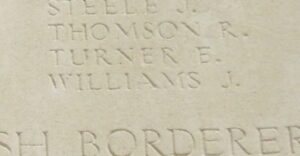
Joseph William Thomas Williams, Private, 34392, Cheshire Regiment. Joseph was the son of Daniel and Sarah Williams, of Brynderi, Abercrave. He worked as a collier prior to enlisting at Newport, Monmouth on 24 March 1916 into the 3rd Battalion, South Wales Borderers. On 30 March 1917 he was transferred to a Labour Battalion of the King’s Liverpool Regiment, and three weeks later was transferred to the 3rd Battalion, Cheshire Regiment. On 6 December 1917 Joseph deserted, and did not re-join his unit until 11 February 1918. He was found guilty of desertion by FGCM and sentenced to three months detention for losing his equipment, but the sentence was rescinded after Joseph volunteered to go to France, and on 26 March 1918 he joined the 9th Battalion, Cheshire Regiment, which was attached to 56 Brigade, 19th (Western) Division. He joined the battalion while it was in the midst of a fighting retreat past Bapaume, following the German offensive of 21 March 1918, and was with the battalion when the division was moved north, to positions near Messines, in the Lys sector, to rebuild. The Germans launched a secondary offensive here on 10 April 1918, and Joseph was wounded by shrapnel in the legs. He spent three months in various hospitals before going AWOL again in July 1918, but gave himself up and was confined to barracks for a week before re-joining his battalion in France on 31 July 1918 in time to take part in the 100 days offensive which would ultimately win the war. Joseph was killed in action during the Battle of the Sambre, on 5 November 1918, aged 35. He is buried in grave IV. H. 6. in Wellington Cemetery, Rieux-En-Cambresis, France.
Llewelyn Oswald Williams, Lance Corporal, 53984, Royal Welsh Fusiliers. Llewelyn was the son of Griffith and Jane Williams, of Penrhiwfarteg, Ystradgynlais. He enlisted at Brecon into the Brecknock Battalion, South Wales Borderers and was posted to France, joining the 17th Battalion, Royal Welsh Fusiliers, which was attached to 113 Brigade, 38th (Welsh) Division. He probably joined the battalion at Ypres and took part in its assault on the Pilckem Ridge as well as the ensuing Battle of Langemarck. The battalion wintered in the Armentieres sector before being rushed to the Somme following the launching of the German spring offensive on 21 March and took up positions north of Albert, facing the Bouzincourt Ridge. Several fierce actions were fought over the coming months to gain control of the west bank of the River Ancre, which was used as the launching pad for the great offensive on 21 August 1918, when the division assaulted the Thiepval Ridge before taking part in the great advance towards and through the Hindenburg Line. By the first week of October 1918 the division was ready to launch an assault on the Beaurevoir Line and the high ground in front of Villers-Outreaux. Llewelyn was leading a party of men who had volunteered to storm a German machine-gun post during the opening day of the battle, on 8 October 1918, and was among eight men killed by a German Whizz-Bang. Llewelyn was 22 years old when he was killed that day and is buried in grave VI.D.5. in Prospect Hill Cemetery, Gouy, France.
Owen Jeffrey Williams, Private, DM2/151520, Royal Army Service Corps. Owen was the son of Evan and Sarah Williams, of Pant-y-Ffynon Cottage, Ystradgynlais. He worked as a slag picker in a colliery washery prior to enlisting at Cardiff into the Army Service Corps. He trained at Sniggery Camp, Liverpool and came home on leave in August 1918 prior to embarking for France and was posted to III Corps Mechanical Transport Company, Army Service Corps as a despatch rider. Owen was serving behind the lines on the Somme when he was badly injured in a motorbike accident and he died of his injuries on 9 September 1918, aged 22. He is buried in grave VII.C.2. in Heilly Station Cemetery, Mericourt-L’abbe, France.
William Arthur Williams, Corporal, 6356, Cavalry. William was the grandson of Martha Richards, of the New Inn, near Marros. He appears to have been the illegitimate son of Martha’s daughter, Leah Jane Williams. William worked as a farm servant for William Ebsworth at Marros Farm before he moved to Ystalyfera and married Gladys Baber, of 22, Canal Street, Ystalyfera, in 1913. William enlisted into the 17th Lancers (Duke of Cambridge’s Own) prior to the war and landed in France on 19 October 1914, joining the 2nd Life Guards, which was under command of the 7th Cavalry Brigade, 3rd Cavalry Division. William joined up with the division in time to take part in the First Battle of Ypres, where the vastly outnumbered BEF stopped the German drive towards the Channel ports by holding the city of Ypres. The division wintered in the Ypres Salient and became caught up in another German offensive just months later, the Second Battle of Ypres, which was launched on 22 April 1915. The opening of the battle was heralded by the first use of poison gas when the Germans launched a gas attack against the French Colonial troops at Gravenstafel. Only brave fighting by the Canadians stopped a break-through, but the battle continued to rage. After weeks of continual fighting, by the second week of May William was in the front line with the 2nd Life Guards near Frezenberg Ridge. At 4 am on 13 May 1915 a heavy artillery barrage opened up on the British line around Ypres and was followed by a massed attack by the German infantry. During a terrible day of fighting, the 3rd Cavalry Division lost over 90 officers and 1,500 men. William, who was 28 years old, was among those killed on 13 May. He has no known grave and is commemorated on panel 5 of the Ypres (Menin Gate) Memorial, Belgium. His widow Gladys later remarried and lived at 4, Emma’s Buildings, Hill Street, Hull.
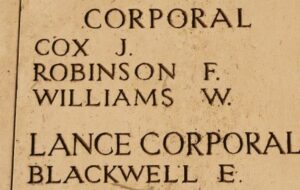
James Woodhouse, Lance Corporal, 21549, South Wales Borderers. James was the son of James and Emily Ann Woodhouse, of Penyworlod, Gelligaer, Glam. Born Bishop’s Froome, Herefordshire. He worked as a coal hewer at Ystradgynlais prior to the war and lodged at Brynwith, Abercrave. James enlisted at Brecon into the 11th Battalion, South Wales Borderers and trained with the battalion at Colwyn Bay and Winchester, before it embarked for France attached to 114 Brigade, 38th (Welsh) Division on 4 December 1915. The division moved to the Fleurbaix sector for trench initiation before taking over the Cuinchy sector and marched south from there in June 1916 to the Somme sector. James was posted to the 2nd Battalion, South Wales Borderers, probably around this time, which was also on the Somme attached to 87 Brigade, 29th Division and was fresh from service in Gallipoli and Egypt. The division suffered terrible casualties during its assault on Y-Ravine on the opening day of the Battle of the Somme on 1 July 1916 and moved to positions at Ypres to rebuild, taking over a section of the canal bank north of Ypres. James was wounded during a routine spell in the trenches here and died of his wounds at Remi Sidings on 28 September 1916, aged 22. He is buried in grave X.B.14A. in Lijssenthoek Military Cemetery, Belgium.
William John Woodward, Gunner, 39822, Royal Field Artillery. William was the son of Albert Victor Woodward and Sarah Ann Woodward, of Middle Lypiatt, Stroud. He was a collier who lodged at St. David’s Road, Ystalyfera prior to the war and married Elizabeth Thomas, of 4, Wind Road, Glanrhyd, in 1913. William enlisted into the Royal Field Artillery and landed in France with the 57th Battery, 45th Brigade, Royal Field Artillery on 17 August 1914. The brigade became attached to the 8th Division, which had been assembled from units from around the Empire and moved to France to reinforce the BEF. The division saw its first major action at the Battle of Neuve Chapelle, and then took part in the Battle of Aubers. It then saw further fighting at the Action of Bois Grenier, before moving to the Somme in 1916. William was wounded towards the end of the Somme offensive, and died of his wounds at the 2nd/2nd London Casualty Clearing Station, Méaulte on 28 November 1916, aged 29. He is buried in grave II.E.31. in Grove Town Cemetery, Méaulte, France.
World War Two, 1939-1945
Benjamin Alexander, Lance Sergeant, 2734183, Welsh Guards. Benjamin was the son of William and Mary Alexander, of Ystradgynlais. He was a pre-war regular and served with the 2nd Battalion, Welsh Guards, which had been formed by Royal Warrant on 18 May 1939. Following the German invasion of France and Belgium, the battalion was posted overseas, and embarked from Dover for Boulogne aboard the SS Biarritz, arriving at 10.00 on 22 May 1940. The BEF were evacuating from France, and the Dunkirk evacuation was drawing to a close, so the 2nd Welsh Guards was charged with the defence of Boulogne while other troops evacuated from its port. During the afternoon the guardsmen came into contact with German recce patrols and tanks and heavy fighting began. Benjamin was killed at some time during that evening of 22 May 1940. The 21-year-old has no known grave and is commemorated on the Dunkirk Memorial, France.
Benjamin Thomas Morgan Baker, Flight Sergeant, 563729, Royal Air Force. Benjamin was the son of Benjamin and Martha Baker, of Cwmgiedd, Ystradgynlais. He enlisted into the Royal Air Force and after qualifying as a pilot, served with 216 Squadron, RAF. The squadron was an Air Transport Auxiliary unit based in the Middle East. On 21 June 1940 Benjamin was flying Bristol Bombay, Serial L5850 towards el-Gubbi, east of Tobruk, when the aircraft came down in the Libyan desert. Benjamin and three other crewmen were killed in the crash, while one man escaped and was taken prisoner by the Italians. The 27-year-old Benjamin and his three comrades are all buried in Knightsbridge War Cemetery, Acroma, Libya.
T. J. M. Baker. This man cannot presently be identified.
James Edward Bamford, Able Seaman, D/JX 349851, Royal Navy. James was born on 27 September 1923, the son of William and Annie Bamford, of Oddfellow Street, Ystradgynlais. He enlisted into the Royal Navy, and was posted to HMS President III, the base for DEMS gunners, and became a gunner aboard the Steam Freighter SS Lulworth Hill. On 19 March 1943 she was on passage from Mauritius for Liverpool when she was torpedoed and sunk by the Italian submarine Da Vinci, with the loss of 36 lives. James was 19 years old when he died that day, and is commemorated on the Plymouth Naval Memorial, Devon.
William Alan Cornelius, Lance Corporal, 4078921, South Wales Borderers. William was the son of Thomas J. and Beatrice A. Cornelius, of Ystradgynlais. He enlisted into the Territorial Army prior to the war. At some time following the outbreak of war, he was posted to the 2nd Battalion, South Wales Borderers. The battalion had taken part in the Norwegian campaign in 1940 and was withdrawn at the end of May when it had become obvious that the country was falling to the Germans. After spending the next four years on home service, the battalion became the only Welsh unit to land on the beaches of Normandy on D-Day, 6 June 1944, landing on Hable de Heurtot. The battalion then took part in bitter fighting around Caen and then during the fighting in the Falaise Pocket. It crossed the River Orne on 10 August and moved towards Falaise, taking part in desperate fighting at Court Genets and Fourneaux-le-Val. William was killed during the fighting around these two villages, on 11 August 1944. The 26-year-old is commemorated on the Bayeux Memorial, France.
Mansel David, Able Seaman, D/JX 168463, Royal Navy. Mansel was born on 20 December 1918, the son of William David and Sarah Ann David (nee Rees), of Ystradgynlais. He enlisted into the Royal Navy and served aboard the Dido class cruiser HMS Charybdis. Charybdis had been with the Home Fleet during the early months of the war, and in April 1942 joined Force H at Gibraltar. She had an active six months In the Mediterranean before being deployed to the Atlantic to search for German blockade runners. She returned to the Med to take part in Operation Torch, then had a refit in the UK before heading back to the Med to cover the landings at Salerno. She then resumed work in the Bay of Biscay, and on 21 October 1943, Charybdis and destroyers HMS Grenville, Rocket and four Hunt class destroyers intercepted the German bloackade runner Münsterland off Ushant, Brittany. The force was attacked at night by the German 4th Torpedo Boat Flotilla, and Charybdis was sunk by two torpedos, going down with the loss of over 400 men. Mansel was 35 years old when he died that day, and is commemorated on the Plymouth Naval Memorial, Devon.
Bryn Davies, Civilian. Bryn was the son of Eleanor Davies, of Oaklands, Gorof Road, Ystradgynlais. He lived in 11, Kensington Place, Notting Hill Gate, London. He was killed during one of the worst V1 rocket strikes against London in the entire war, when one crashed into the Guards’ Chapel, Wellington Barracks during the start of the 11.00 service on Sunday 18 June 1944, killing 121 people, including 63 soldiers. Bryn was 35 years old.
D. Davies. This man cannot presently be identified.
David Glyndwr Davies, Chief Stoker, D/KX 79912, Royal Navy. David was born on 11 September 1909, the son of John and Margaretta Davies, of Upper Cwmtwrch. He was already serving with the Royal Navy at the outbreak of war, and was posted aboard the Hunt class destroyer, HMS Dulverton, which had been launched on 1 April 1941. She was completed by September 1941. Dulverton was utilised for convoy escort duties, mainly escorting troop convoys bound for Suez Canal and also in convoys to Malta. In October 1943 Dulverton was involved in the Dodecanese Campaign, as part of a force that was trying to capture the Greek islands of Kos and Leros. On 12 November, she returned to support the garrison on Leros which had just been invaded by the Germans and on the following day, 13 November 1943, whilst five miles off the coast of Kos, she was attacked by German Dornier bombers and was badly damaged by a direct hit on her bridge. Seventy-eight men, including David, were killed in the explosion. Dulverton was later scuttled and sunk. David was 34 years old when he died that day and is commemorated on panel 81 of the Plymouth Naval Memorial, Devon.
G. Davies. This man cannot presently be identified.
Joseph James Davies, Gunner, 1492341, Royal Artillery. Joseph was the son of Arthur Davies and Margaretta Davies (nee Griffiths), of 8, Craun Cottages, Ystradgynlais. He enlisted into the army and was posted to 9 Coast Regiment, Royal Artillery. The regiment was stationed in Singapore, and formed part of the Singapore Defences. It took part in heavy fighting during the Japanese invasion, and lost its batteries, when they were destroyed on 12 February 1942, so the remaining men marched to the Indian Recreation Ground in Singapore to become infantry support troops. Joseph was taken prisoner on 15 February 1942, following the surrender of the Singapore Garrison, and sent to the Chungkai PoW camp in Thailand and put to work on the Thai Burma railway. Joseph died of sickness whilst in captivity, on 4 November 1943, aged 25. He is buried in Chungkai War Cemetery, Thailand.
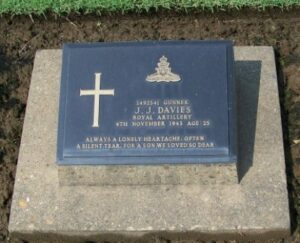
Thomas James Davies, Master, Merchant Navy. Thomas was born at Trevine, Pembrokeshire on 18 August 1906, the son of Benjamin Davies and Kate Davies. He gained his Masters certificate sailing out of Goodwick, and married Olwen Mary Jones, of Ystradgynlais, in 1931. During the war Thomas served aboard the London registered SS Flimston, which belonged to the Picton Steamship Company. Flimston had a lively war. She was attacked by German Stuka dive-bombers on 8 August 1940, in an attack so chaotic that she rammed a fellow steamer, SS Dallas City. She was then grounded in a storm in March 1941. Her crew had to be rescued by HM Coastguard, before returning to the ship later to salvage her. Later in the war she suffered an internal explosion, which resulted in the award of the King’s Commendation to her Chief Engineer George Herbert Davids, OBE. Whether Thomas was injured in this explosion or not is unknown, but he died in hospital in Swansea on 23 September 1944, aged 38. He was buried in Carmel Calvinistic Methodist Chapelyard, Abercrave.
David Douglas Evans, Sergeant, 3025155, Royal Air Force Volunteer Reserve. David was the son of John and Gertrude Evans, of Ystradgynlais. He was a member of the Air Training Corps before enlisting into the Royal Air Force Volunteer Reserve and was posted to No. 12 Operational Training Unit. On 26 August 1944 David took off RAF Chipping Warden aboard Wellington X, Serial LN293 on a training flight. The aircraft crashed five miles outside Bristol, killing all her crew. David was 19 years old, and is buried in St. Cynog’s Churchyard, Ystradgynlais.
Edgar Evans, Corporal, 5259758, Cameronians (Scottish Rifles). Edgar was the son of George Alfred and Rhoda Evans, of Ystradgynlais. He enlisted into the army and was posted to the 1st Battalion, Cameronians. The Battalion had been in India at the start of the war, and was deployed to Burma as part of the 39th Indian Division in 1942. The Japanese invaded India in 1944 and on 8 March crossed the Chindwin River and laid siege to the Garrison at Kohima. At the start of May the Allies launched a counter-offensive. Edgar was killed during this period of fighting on 25 May 1944. He was 22 years old and is commemorated on the Rangoon Memorial, Myanmar.
Henry Garfield Evans, Guardsman, 2735038, Welsh Guards. Henry was the son of John Henry and Gwen Evans of Hendreladis Cottage, Penrhos, Ystradgynlais. He enlisted into the army and was posted to the Welsh Guards. He was taken ill whilst training and died on 17 February 1940, aged 20. Henry is buried in St. Cynog’s Churchyard, Ystradgynlais. His brother, William Stanley Evans, also fell.
William Stanley Evans, Petty Officer Sick Berth, D/MX 45954, Royal Navy. William was born on 30 July 1908, the son of John Henry and Gwen Evans of Ystradgynlais. He enlisted into the Royal Navy on 4 January 1927 and was posted to HMS Victory II, where he trained as a Medic before being posted to Portland Naval Hospital. William married Mary Ellen Davies, of Abercrave, whilst on leave in 1935. He served throughout the war and died in Hay, Breconshire on 12 June 1945, aged 36. He is buried in St. Cynog’s Churchyard, Ystradgynlais. His brother, Henry Garfield Evans, also fell.
Morgan Francis, Private, 4079066, South Wales Borderers. Morgan was the son of Evan and Martha Ann Francis (nee Harris), of Ystradgynlais. He enlisted into the army and was posted to the 1st Battalion, South Wales Borderers, which was in India at the outbreak of war. In November 1941 the battalion was sent to Iraq to protect the oil fields against any German threat, but in May 1942 was sent to North Africa and took up positions near Tobruk. Most of the battalion was captured during the heavy fighting around Tobruk over the coming months and as a result had to be rebuilt. Many of the men who escaped were posted to the 1st Battalion, King’s Own Regiment. Morgan was possibly with the King’s Own when he was killed in Italy on 8 February 1944, aged 25. He is buried in Coriano Ridge War Cemetery, Italy.
Thomas Edward Guppy, Private, 7608634, Royal Army Ordnance Corps. Thomas was the son of John Guppy and Mary Guppy (nee Leyshon), of Lower Cwmtwrch. He was a regular soldier, and served with the Royal Army Ordnance Corps. He was in France with the British Expeditionary Force following the German invasion of Czechoslovakia. Thomas was killed in northern France on 24 May 1940, during the retreat to the coast. The 21-year-old has no known grave and is commemorated on the Dunkirk Memorial, France.
Douglas Hibbard, Bombardier, 1562805, Royal Artillery. Douglas was born on 26 February 1916, the son of William and Edith Hibbard. He worked as a lorry driver prior to enlisting in to the Royal Artillery, and was posted to the 34th Light Anti-Aircraft Regiment. He married Beryl Morgan, of Ystradgynlais, prior to embarking with the regiment for Egypt later that year. Douglas served with the regiment throughout the North African campaign and moved to Italy with it in December 1943. He was killed in Italy on 27 August 1944, aged 29, and is buried in Bari War Cemetery, Italy.
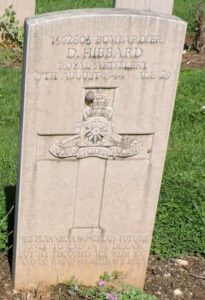
Gwilym Iorwerth Hopton, Gunner, 6404426, Royal Artillery. Gwilym was the son of William and Anne Hopton, of Ystradgynlais. He enlisted into the Royal Artillery and was posted to the 93rd Light Anti-Aircraft Regiment. The regiment had spent much of the war on home defence duties, but elements of it landed in Normandy on D-Day, 6 June 1944. The regiment took part in the break-out of the Normandy beach-head and the drive through Northern France into Belgium and Holland into Germany. The regiment was heavily involved in Operation Plunder, the crossing of the Rhine, in March 1945 and by the time of the Armistice on 8 May 1945 was deployed covering the Rhine crossings. Gwilym appears to have drowned on 13 May 1945. The 30-year-old is buried in Reichswald Forest War Cemetery.
Thomas Watkin Humphreys, DFC, Flying Officer, 171357, Royal Air Force Volunteer Reserve. Thomas was born on 2 April 1917, the son of Charles Maclaren Humphreys and Beatrice Mary Maud Humphreys, of Ystradgynlais. He worked as an electric welder prior to enlisting into the Royal Air Force Volunteer Reserve, and was posted to 117 Squadron, RAF. The squadron reformed on 30 April 1941 at Khartoum, and moved to Egypt in November 1941 to provide transport services. In 1943 it was involved in Operation Husky as part of No. 216 Group RAF and switched to Dakotas based at RAF Castel Benito, Libya. In October 1943 the squadron moved to India and in 1944 it transported supplies for the Chindits who operated behind the Japanese lines. Thomas was awarded the Distinguished Flying Cross as a result of his work in Operation Husky (London Gazette 14 December 1943). He was killed on 8 September 1945 when his Dakota IV, Serial KN593, crashed into the sea off Nyaunggonale, Burma whilst returning from Bangkok with 31 former PoWs. Thomas was 28 years old when he was killed that day and is commemorated on the Singapore Memorial, Singapore.
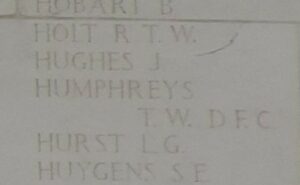
Noah Isaac, Lance Corporal, 4621021, Durham Light Infantry. Noah was born on 9 September 1915, the son of Noah and Beatrice Isaac, of Ystradgynlais. The family had moved to Romford, Essex by 1938 and young Noah was working as a hospital porter. He enlisted into the army following the outbreak of war and was posted to the 16th Battalion, Durham Light Infantry. On 3 January 1943 the battalion landed at Algiers, attached to the 46th Division, and helped push the Germans out of Tunisia. The battalion then took part in the landings at Salerno on 9 September 1943 and helped defend the Salerno perimeter before taking part in the winter campaign, forcing the main Gustav Line in January 1944. Noah was killed whilst fighting on the Gothic Line on 19 September 1944, aged 29. He is buried in Coriano Ridge War Cemetery, Italy.
John David Leslie James, Corporal, 550248, Royal Air Force. John was the son of William David James and Priscilla Jane James (nee Richards), of Ystradgynlais. He enlisted into the Royal Air Force and was posted to RAF Kai Tak at Hong Kong. On 8 December 1941, four hours after the attack on Pearl Harbour was launched, the Japanese attacked Hong Kong. The fighting continued until the British surrendered on 25 December and around 11,000 Allied prisoners went into captivity under the Japanese. John was among those prisoners. He survived less than six weeks in captivity before he died at Argyle Street Prisoner of War Camp on 14 February 1942, aged 25, and is buried in Sai Wan War Cemetery, Hong Kong.
Ronald James, Corporal, 4077384, Monmouthshire Regiment. Ronald was the son of Mr. and Mrs. David James of Queen Street, Pembroke Dock. The family had previously lived at 1, Rowton Villas, Ystradgynlais. Ronald married Dorothy Pritchard in 1941, and the following year their son Ronald Alexander James was born. He served with the 3rd Battalion, Monmouthshire Regiment, which had served with the 53rd (Welsh) Division during the early stages of the war. In the summer of 1942, it was transferred to the 11th Armoured Division of the Royal Armoured Corps. The 3rd Monmouths were originally to move to North Africa, but it was then decided to keep them in England, and the battalion took part in the Normandy Landings. It saw heavy fighting in Normandy and during the subsequent break-out from the beach-head, before taking part in Operation Market Garden. By late November the Germans were being pushed out of Holland towards Germany, and formed a defensive line centred around Kasteel. Ronald was killed during the Monmouths attack on Kasteel on 30 November 1944. The 23-year-old is buried in Groesbeek Canadian War Cemetery, Netherlands.
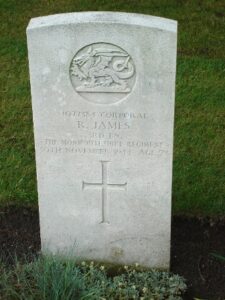
Christopher David Jones, Captain, EC/13434, 10th Gurkha Rifles. Christopher was the son of Edith and Edith Rachel Jones, of Ystradgynlais. The family had moved to Cwmbran prior to 1938 and Christopher worked there as a Draughtsman. He was commissioned into the 10th Gurkha Rifles and had been attached to the Indian Engineers. The 10th Gurkha Rifles had seen heavy fighting in Burma during the war, gaining more battle honours during the campaign than any other unit. Christopher survived the war, but died aboard ship in the Gulf of Siam on 9 May 1946, aged 23. He is buried in Kanchanaburi War Cemetery, Thailand.
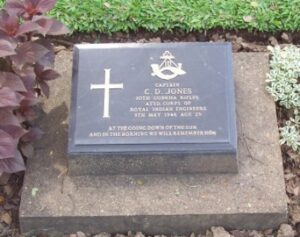
Cyril Edward Jones, Private, 4081407, Monmouthshire Regiment. Cyril was the son of Morgan Roberts Jones and Winifred Jones, of Ystradgynlais. He enlisted into the army and was posted to the 3rd Battalion, Monmouthshire Regiment, which had served with the 53rd (Welsh) Division during the early stages of the war. In the summer of 1942, it was transferred to the 11th Armoured Division of the Royal Armoured Corps. The 3rd Monmouths were originally to move to North Africa, but it was then decided to keep them in England, and the battalion took part in the Normandy Landings. It saw heavy fighting in Normandy and during the subsequent break-out from the beach-head and fighting in the Bocage. Cyril was killed during heavy fighting at Le Perier Ridge, during a vicious German counter-attack on 7 August 1944, aged 24. He is buried in Bayeux War Cemetery, France.
Cyril Eurfryn Jones, Private, 1482147, Welch Regiment. Cyril was the son of Thomas Frederick and Annie Jones, of Ystradgynlais. He served with the Welch Regiment during the latter stages of the war and was injured in a traffic accident in Germany after the Armistice. He died in hospital in Sheffield on 29 August 1945, aged 19 and his remains were brought home for burial in St. Cynog’s Churchyard, Ystradgynlais.
Daniel Thomas Jones, Sergeant, 1199711, Royal Air Force Volunteer Reserve. Daniel was the son of Thomas Lewis Jones and Mary Jones, of Ystradgynlais. He enlisted into the Royal Air Force Volunteer Reserve and was posted to 159 Squadron, RAF. The squadron had reformed at RAF Molesworth on 2 July 1942 and was posted to the Middle East on 12 February 1942 and then to India on 18 May 1942, equipped with Consolidated Liberators, the squadron was posted to Palestine in July 1942 and carried out bombing raids in North Africa, Italy and Greece. Daniel was killed on 24 August 1942 while flying aboard Liberator II, Serial AL537, when it was shot down by flak and crashed near Tobruk, killing all her crew. Daniel was 20 years old when he died that day and is buried in Knightsbridge War Cemetery, Acroma, Libya. The other seven crewmen aboard the Liberator have no known graves and are commemorated on the Alamein Memorial.
J. J. Jones. This man cannot presently be identified.
Jeffrey Jones, Craftsman, 10545918, Royal Electrical and Mechanical Engineers. Jeffrey was the son of David Charles and Elizabeth Ann Jones, of Alltwen. He served with the 9th Armoured Brigade Group Workshops, Royal Electrical and Mechanical Engineers. Jeffrey survived the war but died on 23 October 1946, aged 25. He is buried south-west of the chapel, in row 3, grave 7 in Alltwen Welsh Congregational Chapelyard.
John Jones, Sapper, 4077138, Royal Engineers. John was the son of William John and Mary Jones, of Glanrhyd, Ystradgynlais. He enlisted into the Royal Engineers and was posted to 170 Tunnelling Company. The Company left England in January 1940 to excavate bomb-proof military headquarters in northern France, but soon had to evacuate to England. The Company then joined several other Tunnelling Companies to move to Gibraltar, to work on a massive network of tunnels and chambers the rocky peninsula. By late 1943 the most of the Companies had returned to Britain to convert into engineering units. John was killed during an accident in Cornwall on 19 February 1944, aged 24. His remains were brought home for burial in St. Cynog’s Churchyard, Ystradgynlais.
P. L. Jones. This man cannot presently be identified.
William John Jones, Private, 4074321, Welch Regiment. William was the son of Daniel William Jones and Elizabeth Jane Jones, of Ystradgynlais. He married Lily Louisa Carter, of Godrergraig in 1934. William enlisted into the South Wales Borderers, but was later transferred into the 1st Battalion, Welch Regiment. The battalion had the misfortune to be posted to Crete on 18 February 1941 to garrison the Island as part of CREFORCE, but got caught up in very heavy fighting when the island was invaded by well trained German paratroopers on 20 May 1941. Following a breakdown in communications, Maleme Airfield fell to the Germans on the following day, allowing reinforcements to arrive, and the Allies were pushed southwards to attempt evacuation by the Royal Navy. Surrounded at Suda Bay, the 1st Welch were almost annihilated and only 168 men managed to escape from Crete, leaving behind some 250 dead and over 400 men taken prisoner. William was probably drafted into the 1st Welch following its evacuation to Alexandria. The battalion was rebuilt before being sent to Benghazi and came under heavy attack by Rommel’s Afrika Korps. The Allies were forced into a retreat, and the remnants of the 1st Welch were forced into a withdrawal across hundreds of miles of desert. William was killed during a desperate attempt by elements of the battalion to break through the German lines on 2 February 1942. The 34-year-old is buried in Benghazi War Cemetery, Libya.
Alun Gwyn Lewis, Flight Sergeant, 946288, Royal Air Force Volunteer Reserve. Alun was the son of David Rees Lewis and Margaret Lewis. He enlisted into the Royal Air Force Volunteer Reserve and was posted to 429 (RCAF) Squadron, RAF as a Wireless Operator. The Squadron was a heavy bomber unit initially attached to No 4 Group at RAF East Moor, but was reassigned to the Royal Canadian Air Force in 1943. On 11 April 1943, Alun was flying aboard Wellington X, Serial HE636 which was part of a large force despatched to bomb Frankfurt. The aircraft was intercepted over Germany and shot down by an ME110, crashing near Steinbach-Weier, Hessen with the loss of all five of her crew. Alun was 23 years old when he died that night, and buried alongside his fellow crew members at Rheinberg War Cemetery, Germany. His brother, Llewellyn, also fell.
John James Lewis, Private, 3967429, Welch Regiment. John was the son of Jonathan and Annie Lewis, of Ystradgynlais. He enlisted into the army and was posted to the 1st Battalion, Welch Regiment. The battalion had the misfortune to be posted to Crete on 18 February 1941 to garrison the Island as part of CREFORCE, but got caught up in very heavy fighting when the island was invaded by well-trained German paratroopers on 20 May 1941. Following a breakdown in communications, Maleme Airfield fell to the Germans on the following day, allowing reinforcements to arrive, and the Allies were pushed southwards to attempt evacuation by the Royal Navy. Surrounded at Suda Bay, the 1st Welch were almost annihilated and only 168 men managed to escape from Crete, leaving behind some 250 dead and over 400 men taken prisoner. John was killed near Suda Bay on 27 May 1941, aged 24. He has no known grave and is commemorated on the Athens Memorial, which is located within Phaleron War Cemetery, Greece.
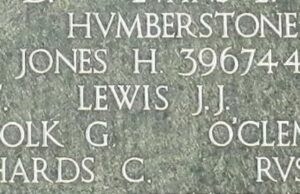
Llewellyn Jeffreys Rhys Lewis, Fusilier, 14200888, Royal Fusiliers. Llewellyn was the son of David Rees Lewis and Margaret Lewis. He enlisted into the army and was posted to the 8th Battalion, Royal Fusiliers, which was attached to the 56th (London) Division. The division embarked for the Middle East in November 1942, and served in Iraq and Palestine, until moving to Egypt in March 1943. It then participated in the final stages of the Tunisian Campaign. The division moved to Italy in September 1943 and fought in the landings at Salerno. It then took part in the advance north, crossing the Volturno Line in October and from January 1944 saw service in the Battle of Monte Cassino. Llewellyn was killed at Monte Cassino on 20 January 1944, aged 22. He has no known grave and is commemorated on the Cassino Memorial, Italy. His brother Alun also fell.
Leonard Llewelyn, Naval Airman 2nd Class, SFX 855299, Royal Navy. Leonard was the son of Evan Llewelyn and Dinah Llewelyn (nee Griffiths), of Abercrave. He enlisted into the Royal Navy after the war and was posted aboard the aircraft carrier HMS Illustrious. She had played an important part in several actions throughout the war and she was converted into a training carrier. Whist at anchor in Portland Harbour on 17 October 1948, one of her boats foundered 50 yards short of the ship in heavy weather, and 29 men lost their lives. Among the dead was 18-year-old Leonard, whose remains were interred in Tynycoed Chapel.
J. Morgan. This man cannot presently be identified.
James John Morgan, Fifth Engineer, Merchant Navy. James was born on 24 November 1915, the son of Thomas and Catherine Morgan, of 2, Ynys-Isaf, Ystradgynlais. He worked as a colliery fitter prior to the war, when he enlisted into the Merchant Navy. He was posted aboard the London registered oil tanker MV Conus. During the evening of 4 April 1941, Conus was dispersed from convoy OB-304, when she was struck by a torpedo from the German submarine U-97 and stopped southeast of Cape Farewell. The U-boat then fired its last two torpedoes and the tanker sank within ten minutes, with the loss of her Master and 58 men. James was 25 years old when he died that day, and is commemorated on the Tower Hill Memorial, London.
John Price Morgan, Sergeant, 626428, Royal Air Force Volunteer Reserve. John was the son of Richard and Esther Morgan of Abercrave. He enlisted into the Royal Air Force Volunteer Reserve, and was posted to 500 Squadron, RAF. The Squadron was attached to RAF Coastal Command, under 16 Group, equipped with the Avro Anson I. It carried out patrols and convoy escort operations off the coast of Essex and East Anglia, before transferring to operations over the English Channel in January 1940 and helped cover the evacuation of Dunkirk. On 28 June 1940 John was flying aboard Anson I, Serial N5226 when it went missing during a reconnaissance mission over the French coast. John was 29 years old when he died that day, and is commemorated on the Runnymede Memorial, Surrey.
David Howard Morris, Aircraftman 2nd Class, 3092433, Royal Air Force Volunteer Reserve. David was the son of Thomas and Margaret Ann Morris, of Ystradgynlais. He enlisted into the Royal Air Force Volunteer Reserve after the war. David died in the Bridgend area on 30 July 1947, aged 19. His remains were brought home for burial in Ystradgynlais New Cemetery.
Alfa Powell, Sergeant, 1181850, Royal Air Force Volunteer Reserve. Alfa was the son of William Powell and Janet Ann Powell (nee Samuel), of Ystradgynlais. He enlisted into the Royal Air Force Volunteer Reserve and was posted to No. 6 Operational Training Unit. On 17 April 1942 Alfa was flying aboard Lockheed Hudson II, Serial T9378, when the aircraft crashed on landing after a training flight in Yorkshire, killing all three men aboard. Alfa was 20 years old when he died that day and his remains were brought home for burial in St. Cynog’s Churchyard, Ystradgynlais.
Harkless Welltion Rowe, Cook, Merchant Navy. Harkless was the son of Horace and Annie Rowe, of Ystradgynlais. He served with the Merchant Navy, aboard the Greek registered Motor Vessel MV Kolchis. On 22 November 1940 Kolchis was sailing across the Atlantic as part of Convoy OB-244, which was unwittingly being stalked by a German submarine Wolfpack. On the following night, 23 November 1940, the Convoy came under attack and within hours, the German submarine U-123, had sunk six vessels, including MV Kolchis. Harkless was 28 years old when he died during the sinking of Kolchis, and is commemorated on the Tower Hill Memorial, London.
David Meurig Thomas, Sergeant, 1316660, Royal Air Force Volunteer Reserve. David was the son of Idwal Vaughan and Elizabeth Gwladys Thomas, of Pontardawe. He enlisted into the Royal Air Force Volunteer Reserve and was posted to Rhodesia to train as a pilot under the Empire Air Training Scheme. He was killed when his aircraft crashed during a training flight on 30 September 1942. David was 20 years old and is buried in grave 52 in Bulawayo (Athlone) Cemetery, Zimbabwe.
David Naunton Thomas, Leading Air Mechanic, FAA/SFX 319, Royal Navy. David was born on 8 January 1921, the son of David Thomas, of Ystradgynlais. He enlisted into the Royal Navy in 1939 and was posted to the Fleet Air Arm, becoming an Air Mechanic aboard the aircraft carrier HMS Hermes. She was the first ever purpose designed aircraft carrier, which was completed just after the end of World War 1. Following the outbreak of war, Hermes was assigned to the Home Fleet, but soon transferred to Dakar to cooperate with the French Navy. She remained there until the fall of France and took part in an attempt to sink surrendered French warships. She then took part in operations in the Persian Gulf and Indian Ocean, before joining the Eastern Fleet at Ceylon. Hermes was berthed in Trincomalee on 8 April when a warning of an Indian Ocean raid by the Japanese fleet was received, and she sailed that day for the Maldives with no aircraft on board. On 9 April a Japanese scout plane spotted her near Batticaloa, and she was attacked by several dozen dive bombers. With no air cover, Hermes was quickly sunk by the Japanese. Most of the survivors were rescued by a nearby ship, although 307 men were lost in the sinking. David was among the dead. The 21-year-old has no known grave and is commemorated on the Lee-on-Solent Memorial, Hampshire.
Harry Prosser Thomas, Private, 4074475, Essex Regiment. Harry was the son of Evan Prosser Thomas and Susanah Thomas, of Ystradgynlais. He enlisted into the army and was posted to the 1/4th Battalion, Essex Regiment, which was attached to the 4th Indian Division. The division saw heavy fighting throughout the North African campaign, and then in the Tunisian Campaign. Harry was killed during the opening hours of a massive attack by the Eighth Army on 20 April 1943. The 33-year-old has no known grave and is commemorated on the Medjez-El-Bab Memorial, Tunisia.
Ivor Bertram Thomas, Sergeant, 1184086, Royal Air Force Volunteer Reserve. Ivor was the son of Harold Charles Thomas and Mabel Hilian Thomas (nee Jones), of Ystradgynlais. He enlisted into the Royal Air Force Volunteer Reserve, and after training as a Wireless Operator was posted to 44 (Rhodesia) Squadron, RAF. The squadron was the first to convert completely to Lancasters and flew their first operational missions in March 1942, attached to Bomber Command. On 22 May 1944 Ivor took off from RAF Spilsby aboard Lancaster III, Serial ND976, which was part of a large force detailed to bomb Duisburg. The aircraft is thought to have crashed into the Schelde Estuary, with the loss of four of its crew of six. The two survivors were taken prisoner by the Germans. Ivor was 23 years old when he died during the crash, and is buried alongside his fellow crewmen at Leopoldsburg War Cemetery, Belgium.
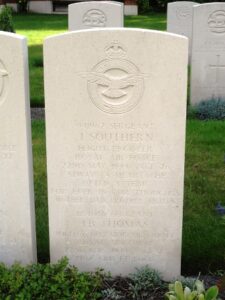
Islwyn Thomas, Warrant Officer, 1283921, Royal Air Force Volunteer Reserve. Islwyn was the son of Arthur and Mary Thomas, of Ystradgynlais. He enlisted into the Royal Air Force Volunteer Reserve and was posted to Wigtown, in Scotland. On 5 November 1945 Islwyn and a friend were walking back to camp along a railway line when they were hit by a train and killed. Another airman and a WAAF who were with them managed to jump away from the line and escaped. Islwyn was 27 years old when he was killed that night and his remains were brought home for burial in Tyncoed Congregational Chapelyard.
Kenneth Vernon Thomas, Warrant Officer, 1389444, Royal Air Force Volunteer Reserve. Kenneth was the son of Stanley and Gladys Thomas, of Ystradgynlais. He enlisted into the Royal Air Force Volunteer Reserve, and was posted to 47 Squadron, RAF, which was based in Egypt, carrying out anti-submarine patrols around the eastern Mediterranean. The Squadron re-equipped with Bristol Beaufort torpedo bombers in 1942 and carried out anti-shipping strikes against enemy convoys supplying the Afrika Korps in Libya until 1943, when it had moved to Tunisia and re-equipped with Bristol Beaufighters. The squadron moved with the Beaufighters to India in March 1944, re-equipping with de Havilland Mosquitos, but the Mosquitos were found unsuitable for use in hot climates, to the Beaufighters returned. Kenneth died in India on 8 February 1945, aged 28. He is buried in Imphal War Cemetery, India.
Keith Webb, Lance Corporal, 4079043, Essex Regiment. Keith was the son of Edith Maud Webb, of Ystradgynlais. He enlisted into the army and was posted to the 1/4th Battalion, Essex Regiment, which was attached to the 4th Indian Division. The division saw heavy fighting throughout the North African campaign, before moving to Italy in January 1944. It took part in heavy fighting during the attacks on Monte Cassino, and then in the continuous fighting northwards past Rome. Keith was killed in Italy on 13 July 1944, aged 24. He is buried in Arezzo War Cemetery, Italy.
John Charles Wight, Able Seaman, D/JX 208770, Royal Navy. John was born at Swansea on 2 March 1910, the son of John Charles and Catherine Wight. He married Phoebe Marietta James, of Ystradgynlais in 1936. John enlisted into the Royal Navy following the outbreak of war and was posted aboard the destroyer HMS Mahratta. She had been commissioned in April 1943, her launch having been severely delayed after she had been damaged in an air raid in May 1941. She had taken part in several operations before being assigned to escort duties on the Arctic Convoys. On 11 February 1944 Mahratta set off from Loch Ewe, escorting Convoy JW-57, bound for Kola Inlet. The Convoy was spotted by German aircraft on 23 February, and began being trailed by German U-Boats. Mahratta was struck by two torpedoes from U-990 on 25 February 1944, and sank with the loss of 220 men. John was 33 years old when he died during the sinking and is commemorated on the Plymouth Naval Memorial, Devon.
Cedric Watcyn Williams, Squadron Leader, 26219, Royal Air Force. This man cannot presently be identified. Cedric was born on 1 February 1910, the son of Gwilym Thomas Williams and Margaret Ada Williams, of Wern Road, Ystalyfera. He enlisted into the Royal Air Force on 14 September 1926, and trained as a pilot. He married Ellinor Morgan at Ystradgynlais in 1937. Following the outbreak of war, Cedric had risen to the rank of Squadron Leader, and after converting to Hurricanes, was given command of 17 Squadron, RAF on 18 July 1940. His squadron flew Hurricanes and defended southern England during the Battle of Britain. Cedric had shot down two enemy aircraft and shared three others when his Hurricane, Serial R4199, was brought down over the English Channel on 25 August 1940. The remains of the 30-year-old were never recovered, and Cedric is commemorated on the Runnymede Memorial, Surrey.

David Jestyn Williams, Civilian. David was the son of David R. and Elizabeth Williams, of Ystradgynlais. He lived at 51, Gloucester Gardens, London. He was killed near St. Mary’s Hospital, London during an air raid on 24 September 1940. The 37-year-old is buried in Paddington.
Sydney Woodcock, Gunner, 125822, Royal Navy. Sydney was born on 13 May 1910, the son of William and Amelia Woodcock, of Maesymeurig, Gurnos, Lower Cwmtwrch. He enlisted into the Royal Navy on 13 May 1928 and trained aboard several ships: HMS Ganges, HMS Marlborough and HMS Caledon, before passing as a Gunner. Following the outbreak of war, he was serving aboard the light cruiser HMS Curacoa, which had just completed being converted into an anti-aircraft ship. She took part in the evacuation of troops from Norway where she suffered damage from German aircraft and following repairs took part in convoy escort duties. On 2 October 1942 she rendezvoused north of Ireland with the RMS Queen Mary, which was carrying 10,000 American troops to Britain, to escort her back to Liverpool. Some confusion followed, which resulted in the Queen Mary colliding with Curacoa, and slicing the cruiser in half. Curacoa sank quickly, with the loss of 337 men, Sydney was 32 years old when he died that day. He is commemorated on the Chatham Naval Memorial, Kent.
